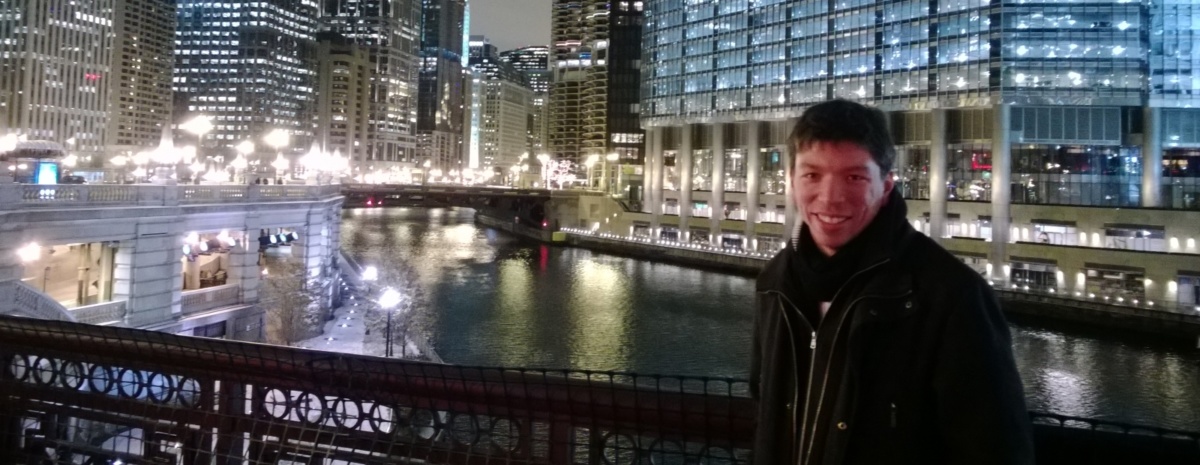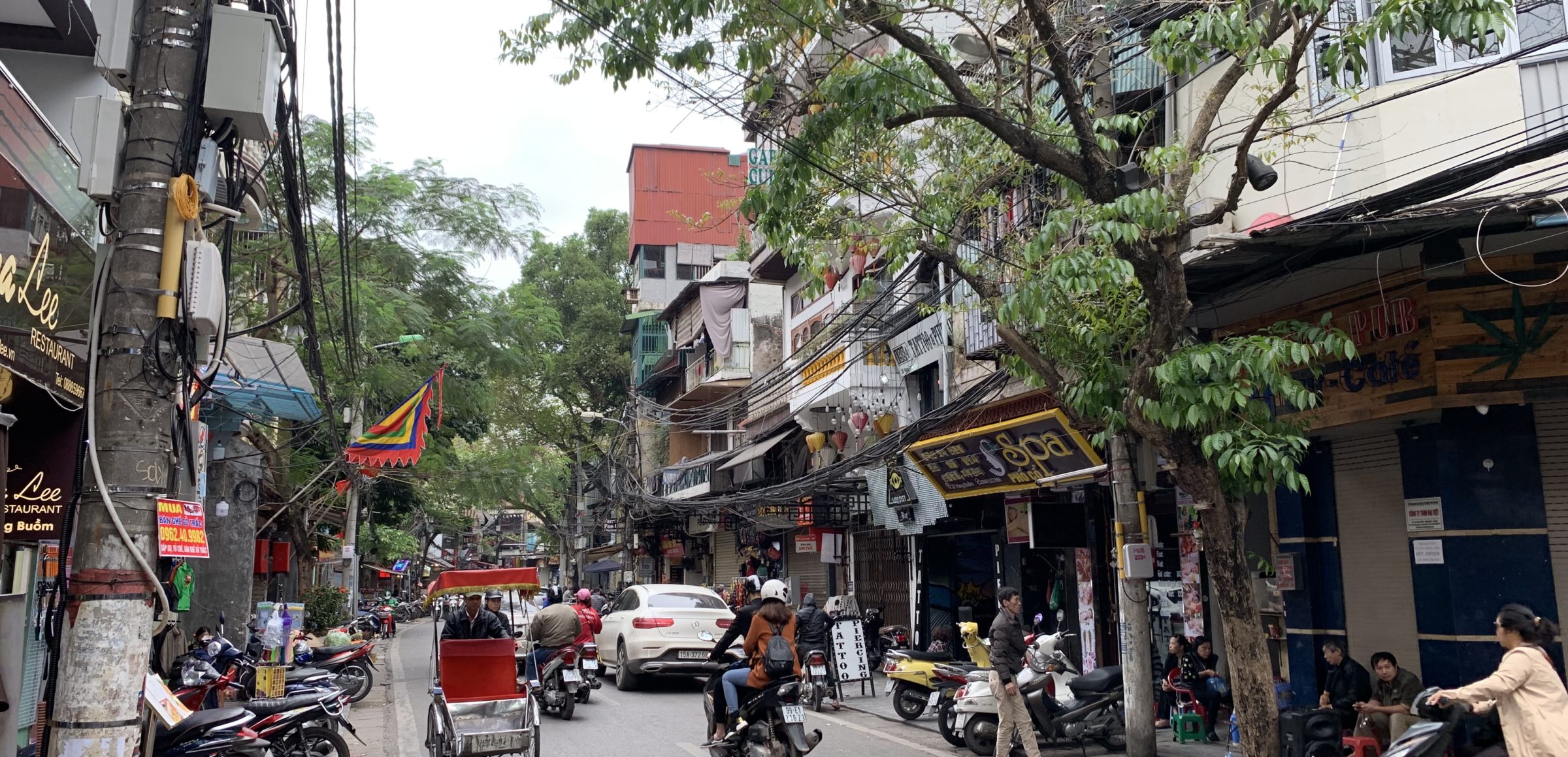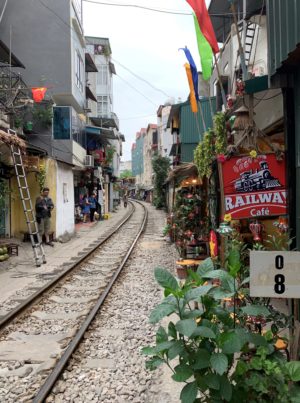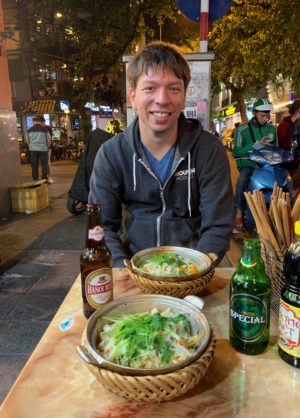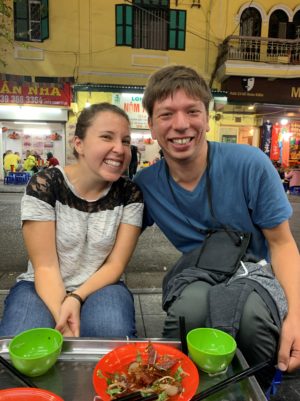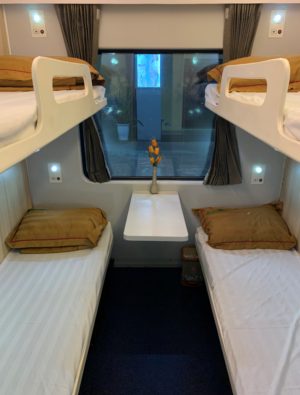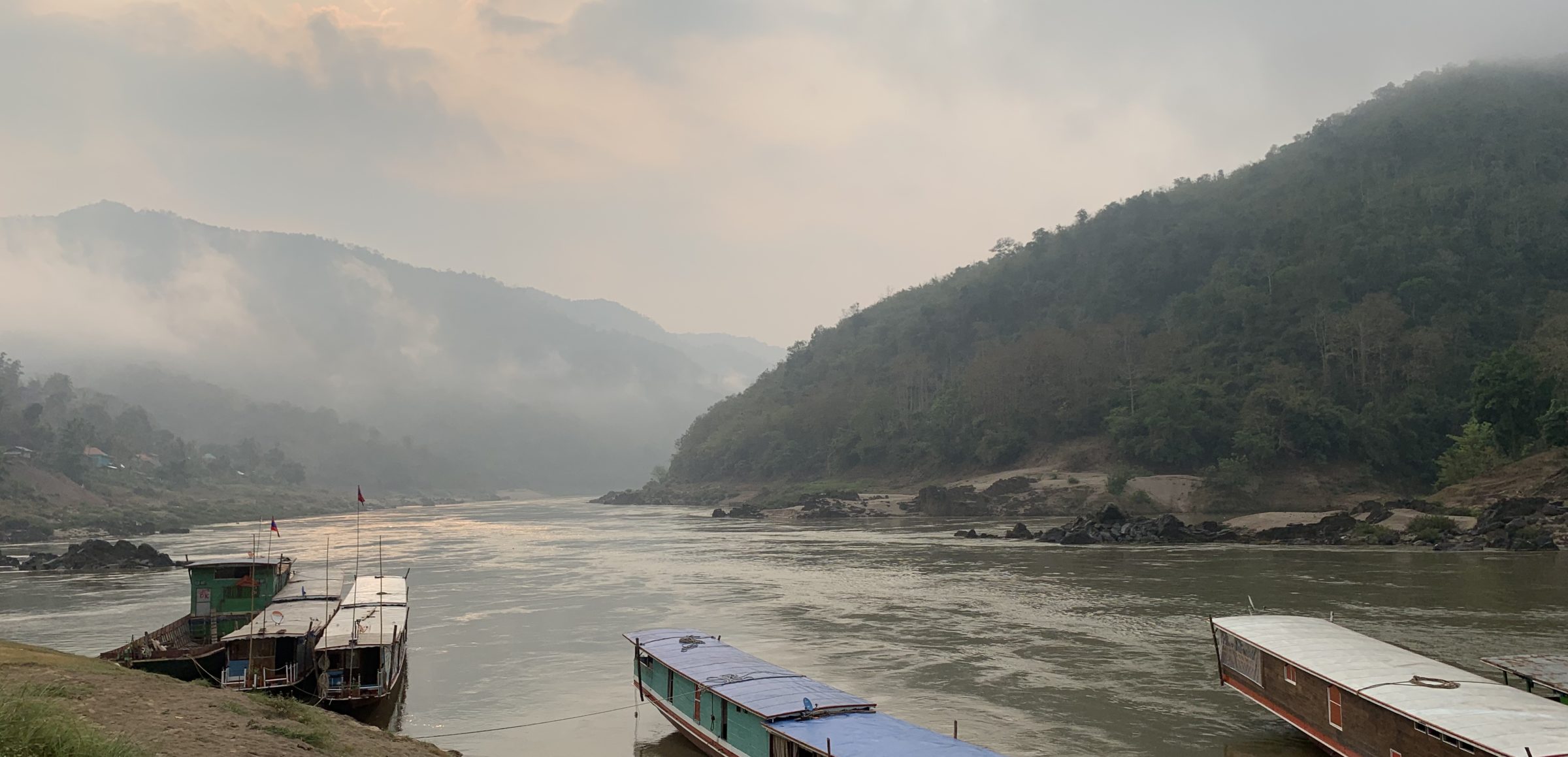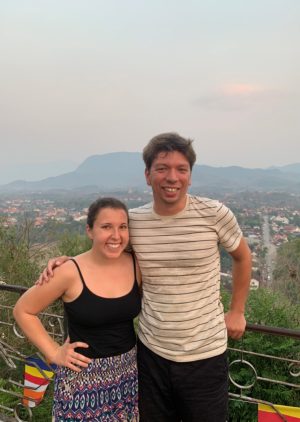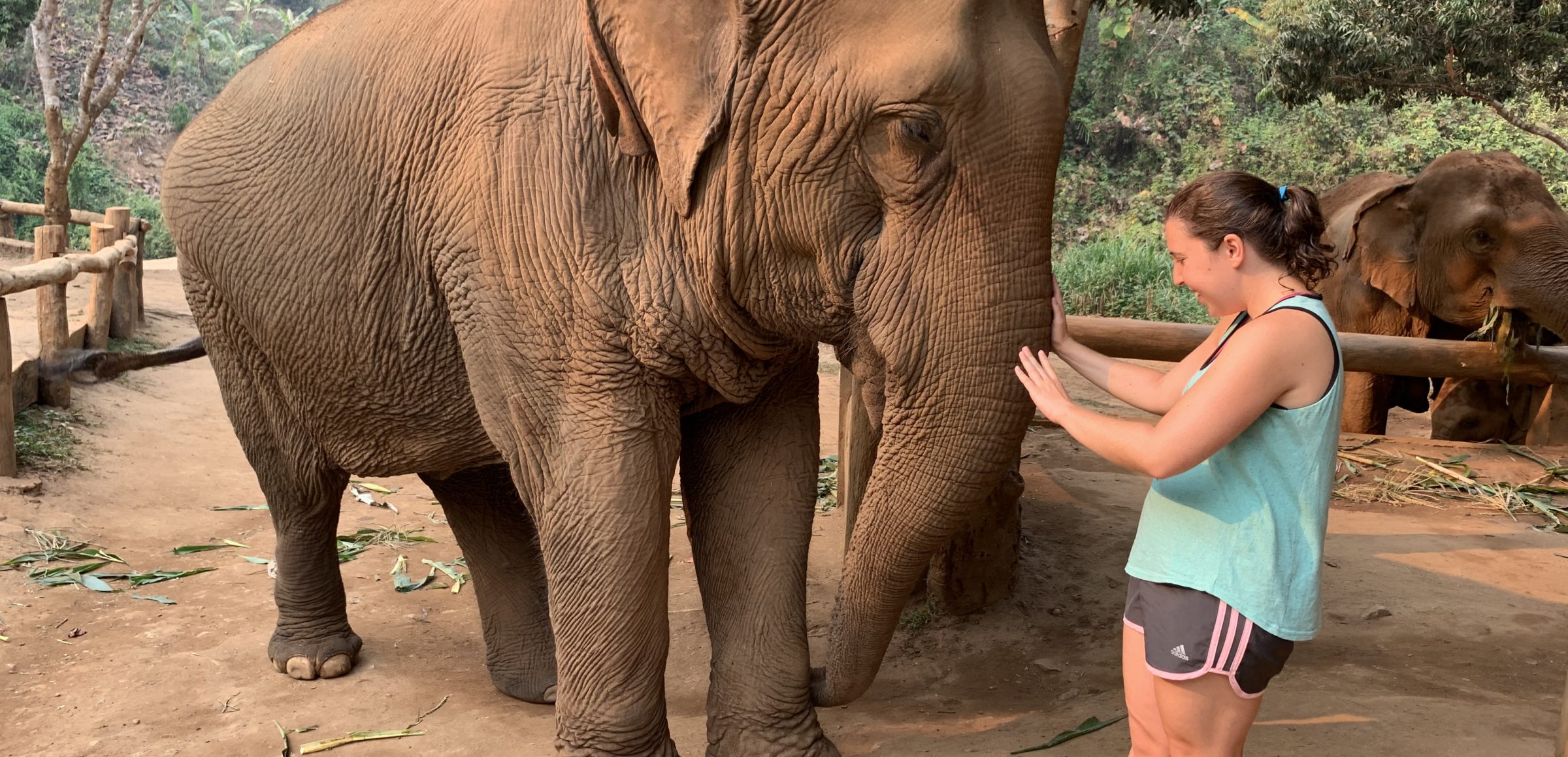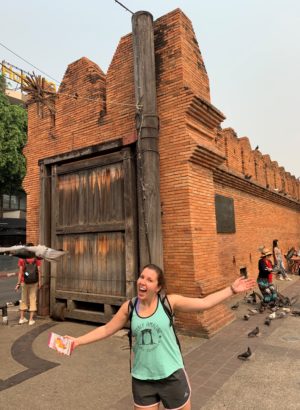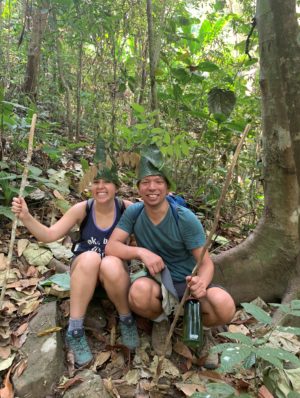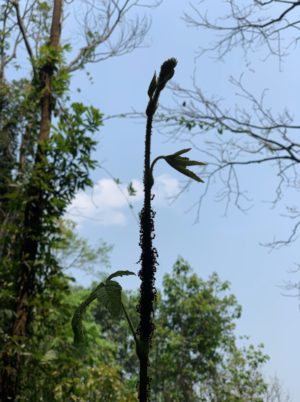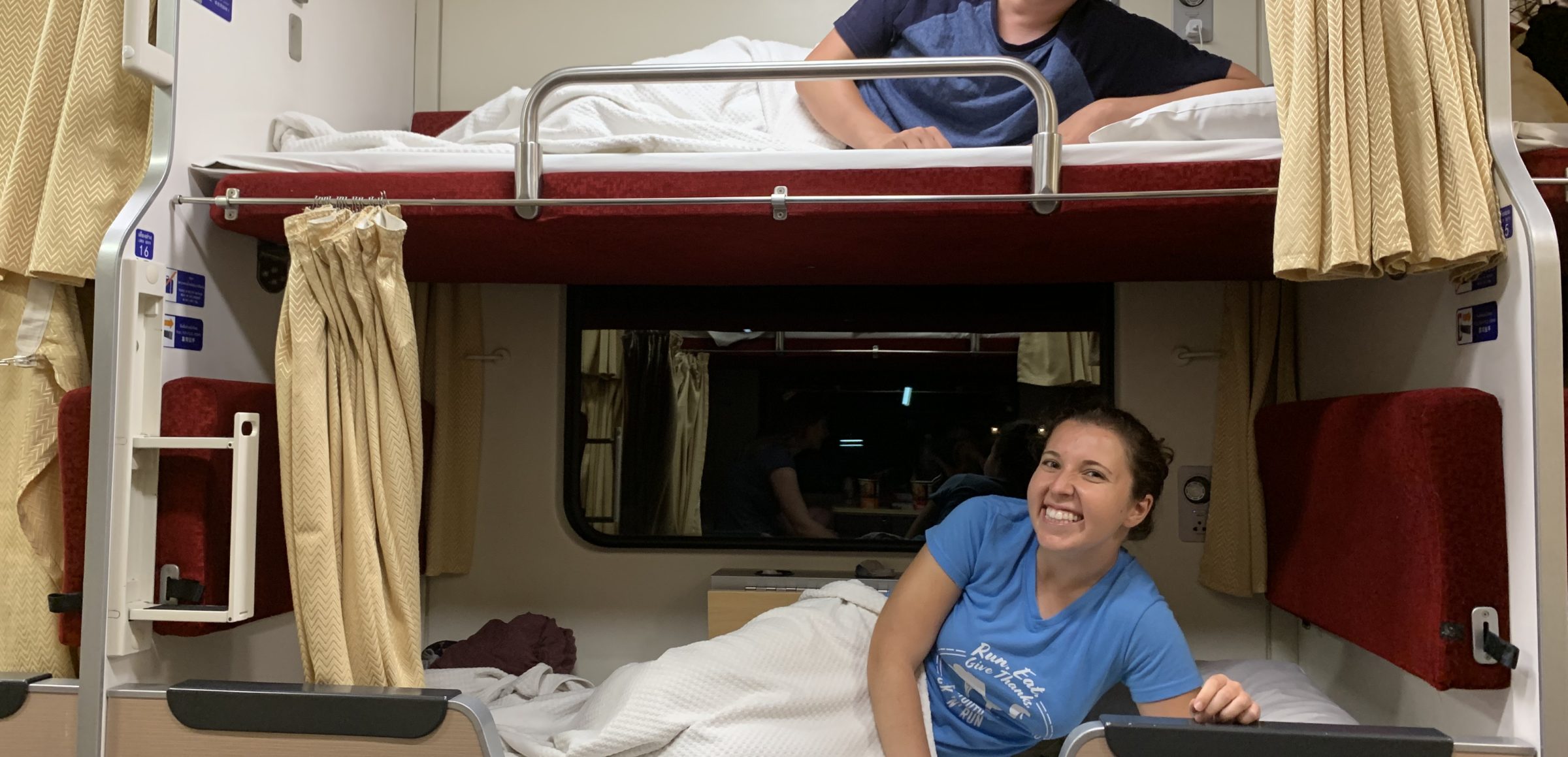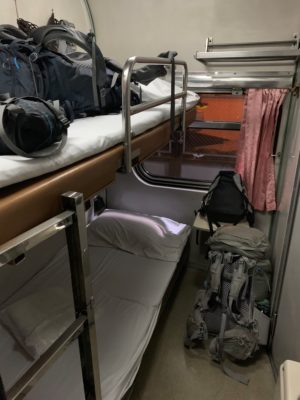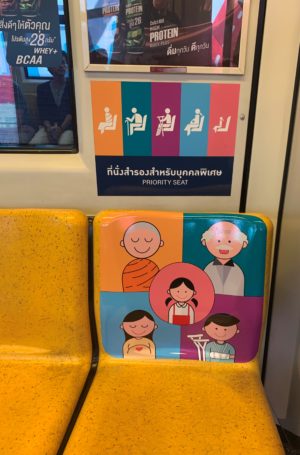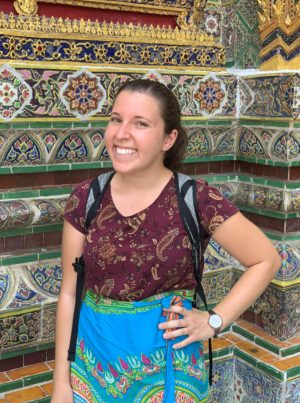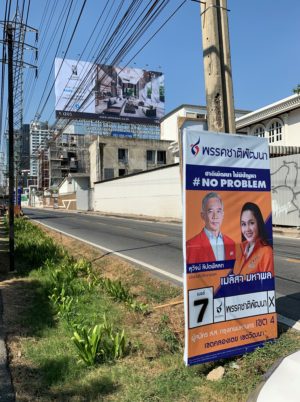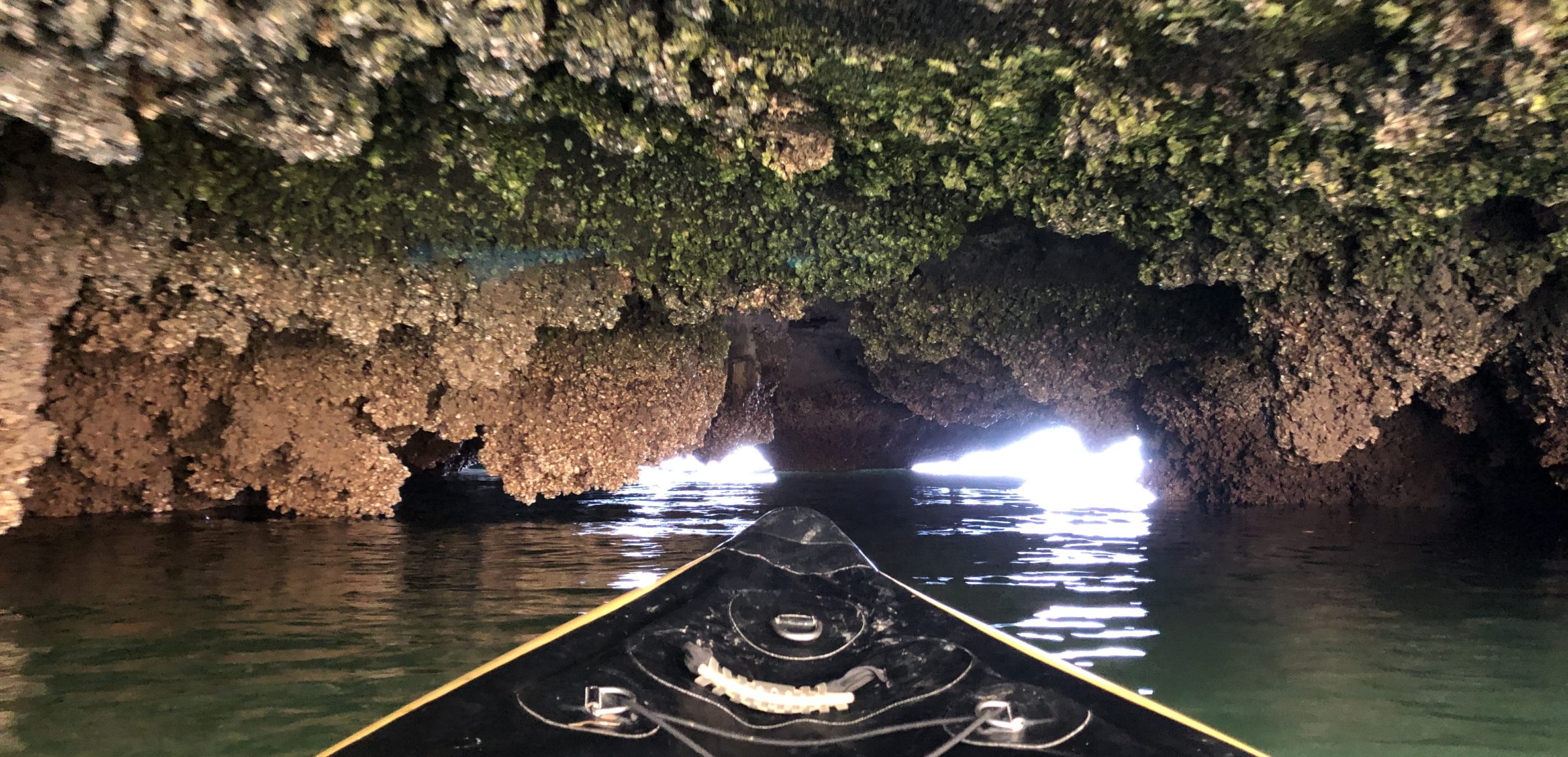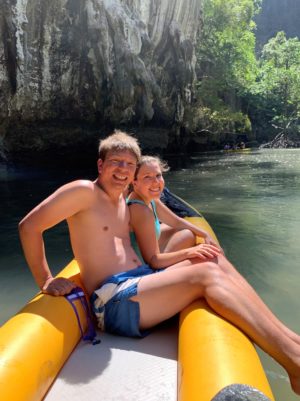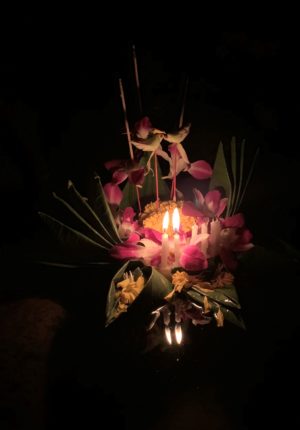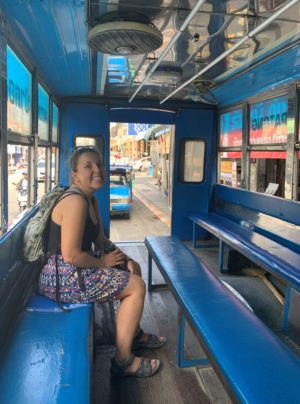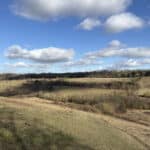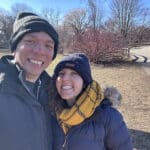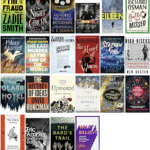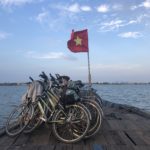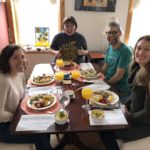One last word of praise for Laos, in case there wasn’t enough in the last post: the butter chicken curry at the airport was swiftly made, cheap and delicious. The world has a lot to learn about airport dining from Luang Prabang. From there we spent a mere 38 minutes in the air until we touched down in Hanoi to begin our journeys in Vietnam. After five days we were both really, really impressed by this city and I totally understand why people sing its praises. I’ve never felt at a loss of things to see or do, even without any organised excursions.
This was definitely helped by staying in the Old Quarter, where the streets are inherently photogenic and almost everywhere is within easy walking distance. As we were warned, the roads are crammed full of motorbikes and crossing the road involves purposefully forgetting everything you ever learnt as a child. Traffic lights mean nothing and the only way to get across is to stride purposefully into the road. Looking left and right as you cross is actively dangerous, since you’re more likely to freeze and fail to move forward to where the drivers have already calculated you will be. At one point at a busy crossing a woman just took me by the arm and marched me across, clearly figuring that I wasn’t going to get there on my own. This slow-mo video of Randi doesn’t capture the vast numbers of bikes, but was the best way I could think to demonstrate the Matrix-esque ‘bullet time’ experience of becoming as zen as possible and letting the traffic flow around you.
Other than crossing the roads, however, the Old Quarter is very walkable and the area around the nearby lake, Hoàn Kiếm, becomes totally pedestrianised at the weekend, starting on Friday nights. Wandering around here was our favourite part of Hanoi as the city felt so vibrant and alive, with lots of seating areas by the lake itself. The legend of Hoàn Kiếm is that this was where the Emperor had to return his magic sword (which had successfully been wielded against China during a war) after a golden turtle appeared in the lake and asked for it back. Knowing this story in advance of going to a Water Puppet Theatre show was very helpful for understanding what on earth was going on.
No, there is no rapid transit system… yet. But the Hanoi Metro – the first of its kind in Vietnam – is supposed to start operating later this year! I will be quite happy to come back in a couple of years to check on its development.
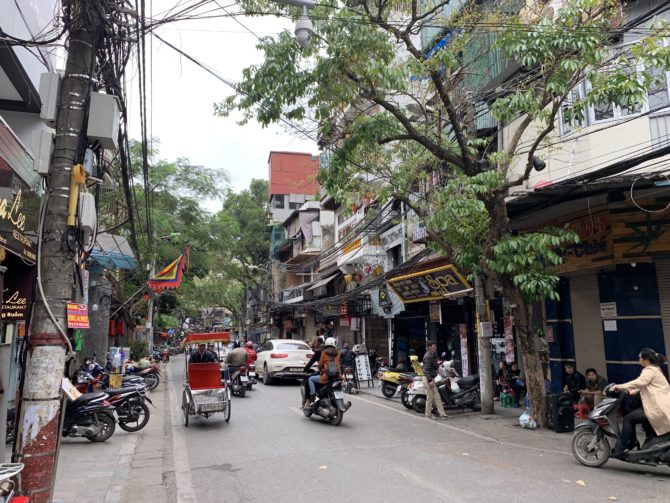
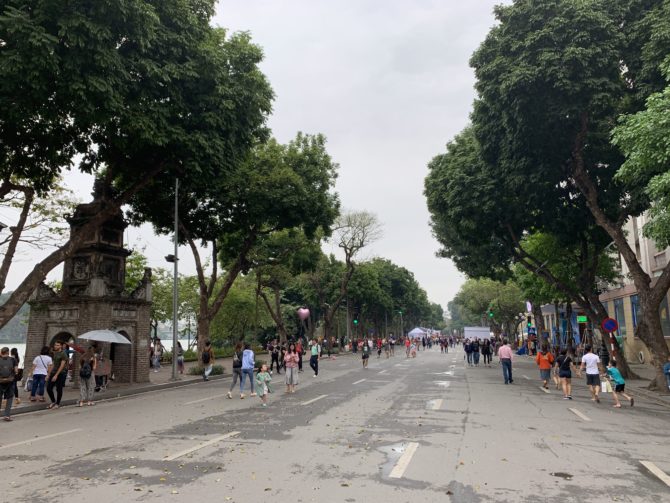
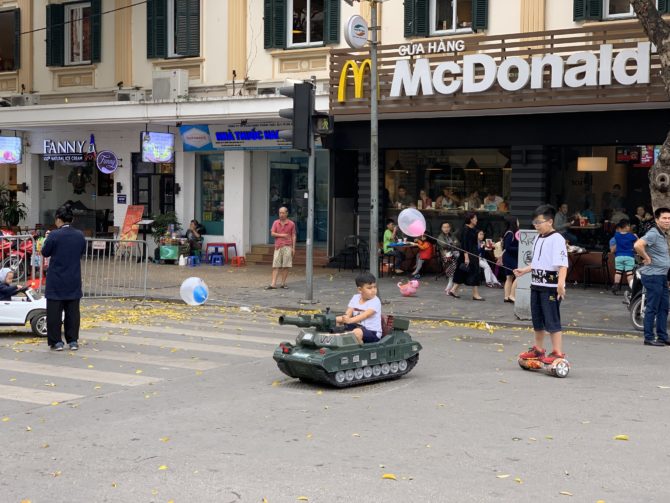
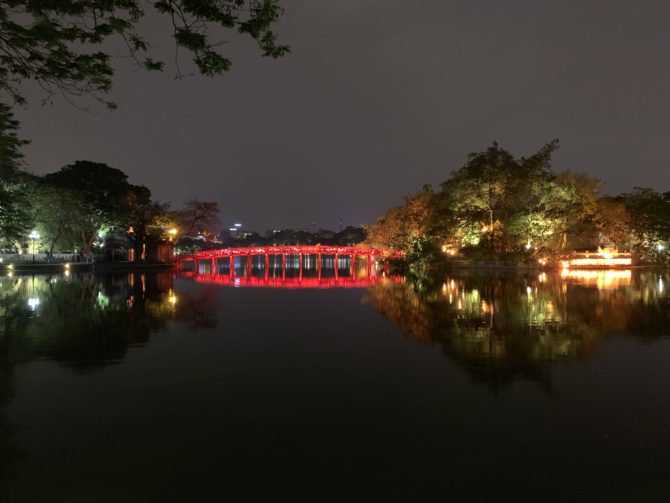
The story of the golden turtle was relayed to us during our student-run walking tour of the Old Quarter. This wasn’t exactly the typical walking tour experience: the main purpose seemed to be as an English-language learning exercise for the organisers, who were visibly excited to learn that Randi and I were both native speakers. Together with a German couple we took turns to chat with our guide as we wandered around the streets, not really stopping to talk much about our surroundings but getting a chance for a really interesting conversation about gender roles in Vietnam today. We also walked on some train tracks to take photos having been assured that no trains were scheduled at this time, which shows a surprising faith in railway timetables.
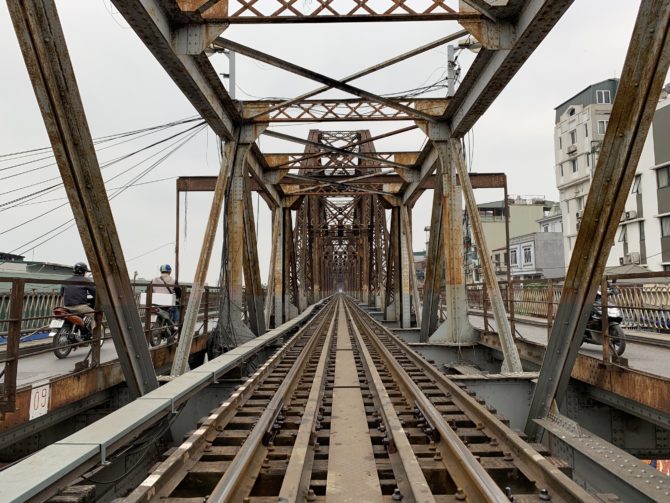
We also visited the Women’s Museum, with exhibits on female fighters in war and Vietnamese family life. My favourite game was to compare the different gifts which a bride’s family can expect depending on which ethnic group is marrying. It varies a lot. Some are in line for ‘hundreds of silver coins’, others for a machete and a pick axe, while other groups set the bar a little lower at chicken thighs. We also learnt that parents sometimes give a temporary ‘ugly’ name to their newborn child to make it undesirable to evil spirits. Examples of these ugly names were not given, but I’d like to think they are all Western ones.
I also enjoyed seeing the Temple of Literature – which was filled with graduating students when we visited – although we didn’t spend very long there. Unlike some places (*cough* Bangkok’s Grand Palace *cough*) all of the entry fees in Hanoi have been very reasonable so there’s no pressure to stay for a long time, and the weather has been mercifully cooler than the rest of our Asian explorations so we could even give the suncream and mosquito spray a break. On our last couple of days the city did descend into a polluted mist which was especially evident on the morning we decided to visit the Ho Chi Minh Mausoleum. Uncle Ho, as he is known here, was keen on a simple cremation but found that it’s very easy to be ignored after you’re dead and now visitors queue up (mornings only) to shuffle past his embalmed body. There are guards present who would presumably stop anyone who tried to break the rules by taking a photo – and to be honest, I wish there were more tourist spots where photography was so strictly prohibited that you can all look without dodging other people’s camera shots.
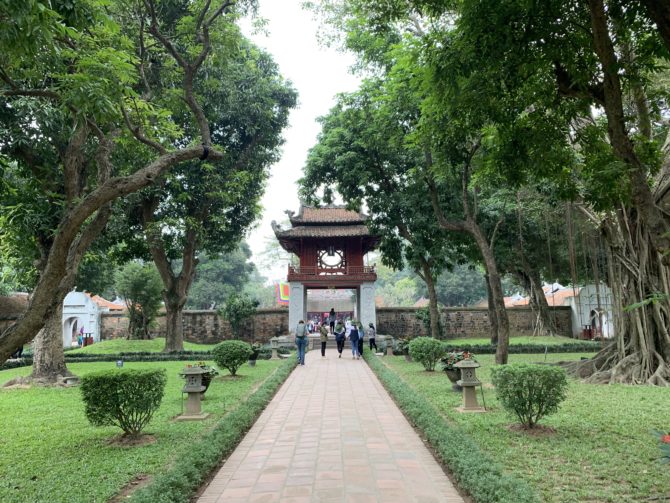
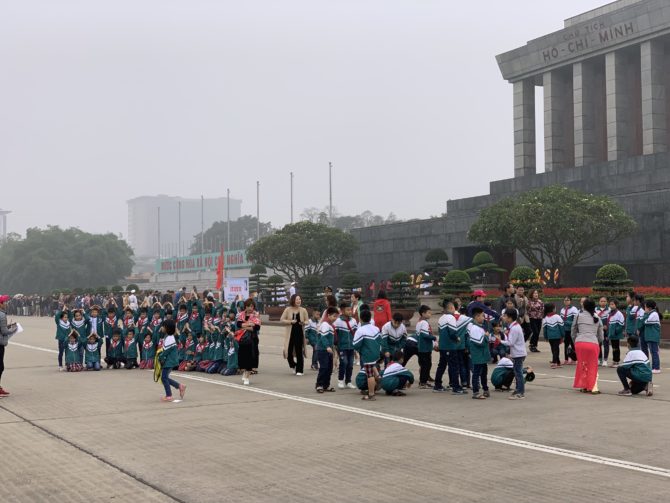
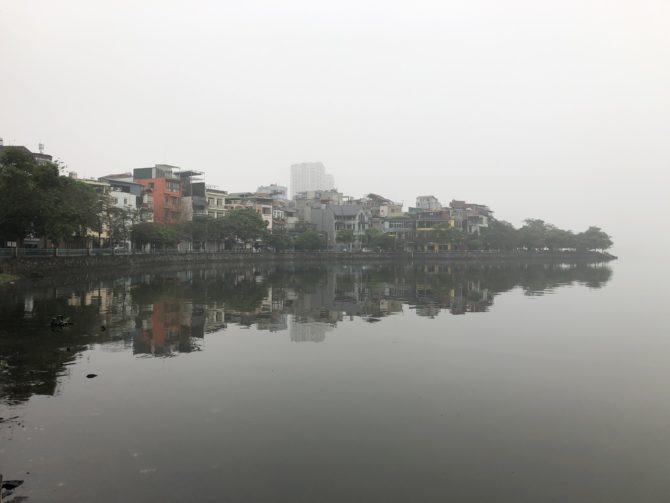
There’s an odd quality to the Mausoleum and a couple of the government buildings nearby, decked out in the requisite hammers and sickles and built in a grey Marxist-Leninist style to match the sky. In Russia, the collapse of the USSR provides a sudden historical break point. You can still find the statues of Lenin there, but they belong to a past era to inspire curiosity or nostalgia or indifference or revulsion or whatever. In Vietnam, it still feels obviously anachronistic to see a statue of Lenin in the post-1990s reform era and yet there he is (away from the Old Quarter, towards the more Sovietesque park with the rundown-looking bumper cars) and so too is the same one-party state. Indeed, as a reminder of what lies in the background, the BBC seemed to be blocked on at least one internet connection we used although not on others.
Similar ambiguities are on display at what remains of the Hỏa Lò Prison. The majority of the exhibition is about the use of the prison by the French colonial forces to detain, torture and execute Vietnamese prisoners, although the references to exactly who was doing the detaining are noticeably watered down in the French translations. It then moves on to the use of the prison to hold American prisoners of war during the Vietnam War, most notably John McCain, in what was dubbed the ‘Hanoi Hilton’. We learn that for American pilots this was a “serene period of their lives” with plenty of fun group activities and holiday celebrations. Except we all know that this is obviously untrue, and prisoners were tortured here. The tourists know it, and the Vietnamese authorities know that we know it, and it takes a certain mindset to keep insisting on something which is obviously false rather than opt for a subtler approach.
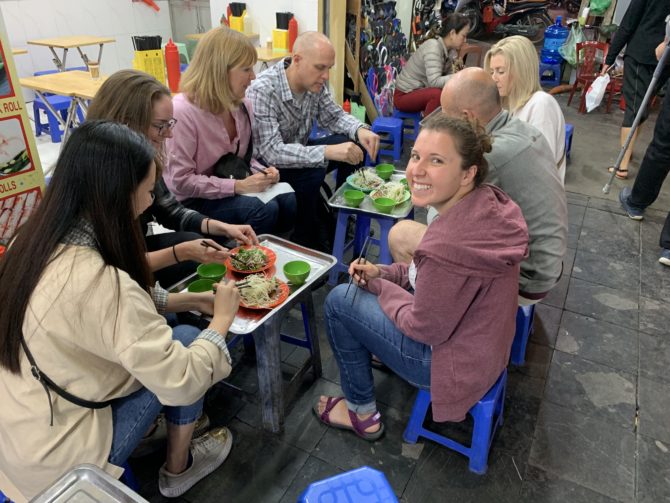
Much more fun than the prison – and one of the very best things we did in Hanoi – was our street food walking tour on Monday evening. In a small group of Brits (and Australians… originally from Britain) we were guided through eight different restaurants to sample everything from bánh mì to glass noodles to the delicious egg coffee which is a speciality of Hanoi. One restaurant was notable for displaying a large topless photo in the corner of its owner when he was in his 20s. We saw him outside (roughly two decades on) and he feigned embarrassment very unconvincingly. Overall, the food tour did not skimp on the portion sizes and by the coconut ice cream finale I was stuffed.
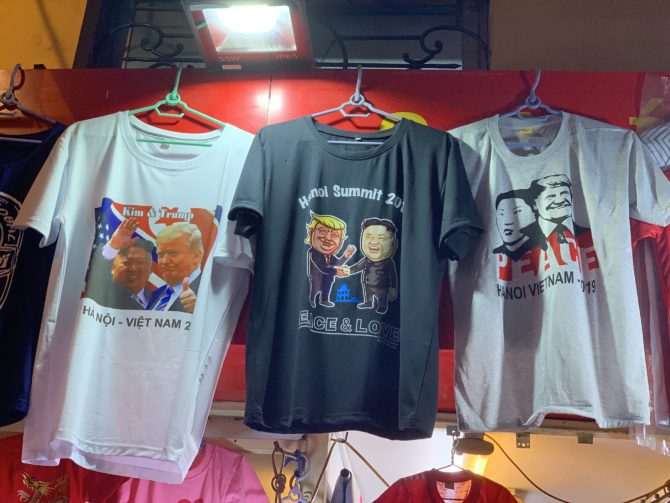
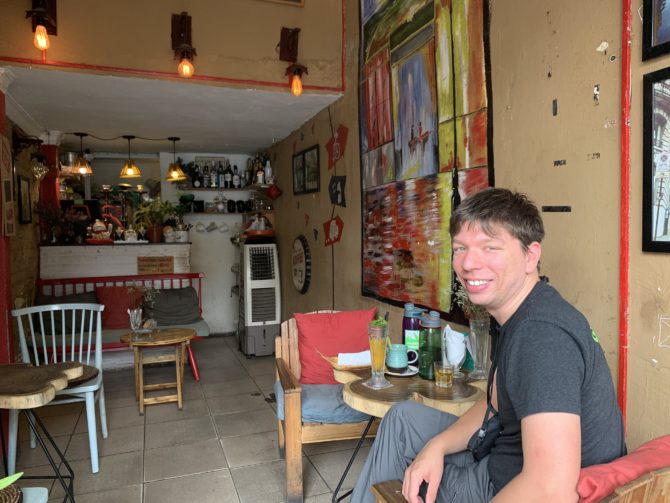
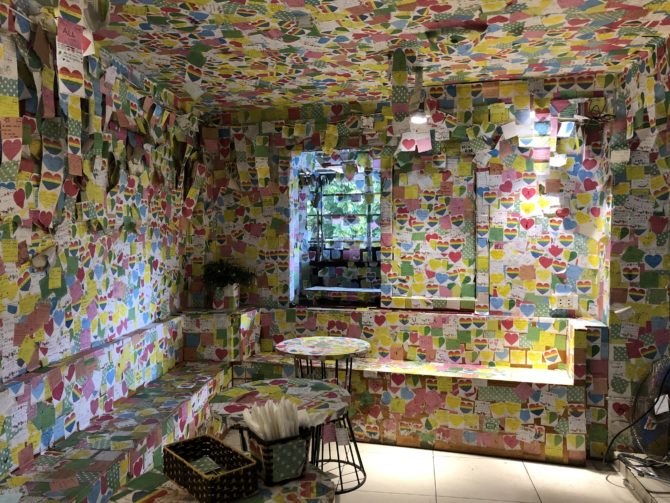
On our last day we headed back to The Note Coffee to blog, a café which (as you can see) is festooned with post-it notes. Here we ran into one of Randi’s old school friends who just happened to be in Hanoi, and our blogging was paused for a great conversation about the world. Then, after dinner, we headed for the railway station for our next overnight train to Hue. Unfortunately Randi was in the midst of a sinus infection by this point so it wasn’t a perfect journey, but the train was perfectly comfortable and ran on time. The only issue for me was that the ride was pretty bumpy, which left me with a headache when I foolishly tried to read before bed.
I’m struggling to finish this post because it was written in so many fits and starts that I’m worried I’ve lost the thread of Hanoi and failed to do justice to the city. The streets just have so much character and the city feels like a confident, busy place which is not overwhelmed by tourism but treats its visitors well. Just make sure that you plan any visit here to include a weekend to take full advantage of the lake!
Bonus English Language Time
Here is an English lesson on Vietnamese TV:
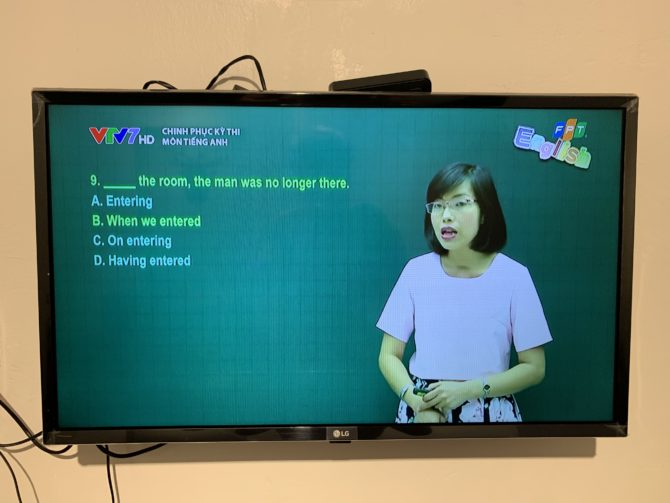
I dispute that this is the only acceptable option. For example:
“We saw the ghostly figure from the window but continued to walk on. On entering the room, the man was no longer there.”
Of all the countries we’ve visited, Laos is the one I had the fewest preconceptions about. I wasn’t even sure how to pronounce it, although after some googling I’m sticking with Laos (rhyming with blouse) rather than Lao (which some travellers use) although it is the Lao people, the Lao language and so on. I very vaguely recalled that it was bombed by the US during the Vietnam War, although my memory was not commensurate with the extent of the bombardment it suffered. I knew there were no trains for us to travel on – although construction of a Chinese railway is underway and we saw the evidence of this from our boat – and that it was the only country on our travels (apart from Singapore, weirdly) where my global data roaming would not work. So all in all, Laos seemed like a rather mysterious bridge we were passing through between Thailand and Vietnam so as not to break our circle around Southeast Asia.
Perhaps unsurprisingly, with little expectations, we have really enjoyed our time here. It’s an annoying cliché for tourists to announce that they have found “less touristy” places, and the places we have visited are not actually “less touristy” than Thailand in terms of how local people make a living. Indeed, according to our AirBnb host in Luang Prabang, the entire economy of this city is based on tourism so it’s worrying that visitor numbers have dropped off in the last few years, most likely due to the Chinese economic slowdown. But Laos is considerably less busy than Thailand. The pace is calmer and more relaxed. There’s even a nationwide curfew at midnight to protect the early-morning giving of alms to monks, and as the sun goes down the relative lack of street lighting contributes to this peaceful mood. Wandering through the night market of Luang Prabang is worlds away from Bangkok or Chiang Mai. At one point in our planning we considered skipping Laos – I’m so glad we didn’t.
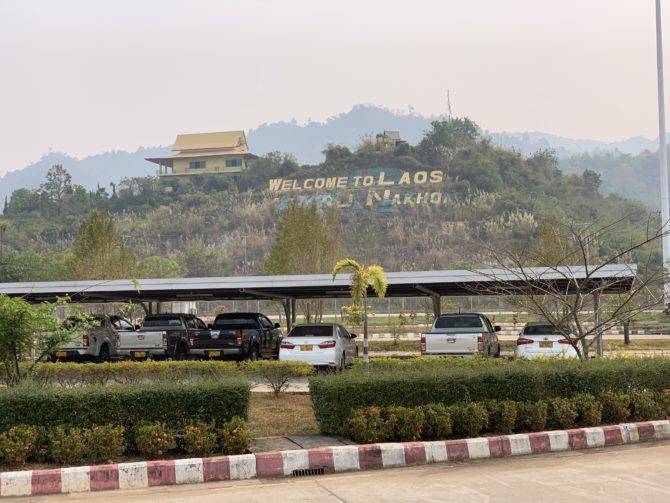
Our little minivan of travellers was playing techno music at a subdued volume as we drove to the Thai border at 8 in the morning, got our exit stamps and then crossed from left-hand-side to right-hand-side driving as we made it over the Thai–Lao Friendship Bridge. The process for purchasing your visa on arrival is somewhat strange. After filling out multiple forms with the same information (which, as usual, are never used and never seen again) they take your passport to stick in a full-page visa and then pass it to someone else for them to try and recognise your face and match it up with the right passport photo. Understandably they do not always get this right, so there is a lot of “nope, that’s someone else” until you get your passport back and are free to enter the country.
From here we took a slow boat along the Mekong River for two days to Luang Prabang, stopping for the night at the small town of Pak Beng. On the first day our group was a little late to the boat and the only seats left were the sideways benches at the front, which were not hugely comfortable. Randi and I spent a lot of the journey sitting on the floor instead, but the atmosphere was nice and we worked hard to convince two young children to keep poking our noses for our mutual entertainment.
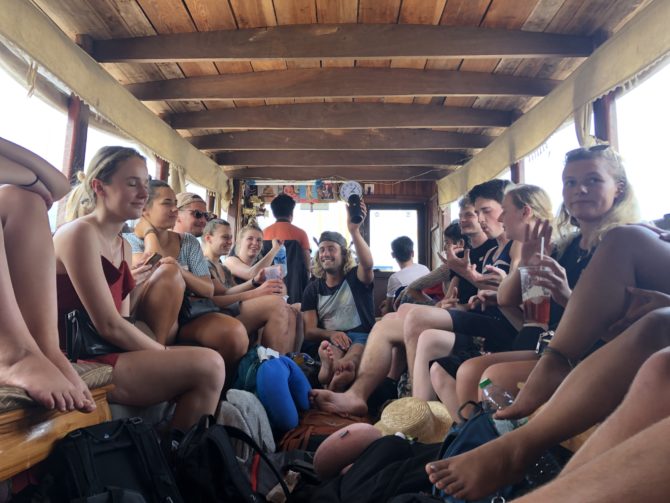
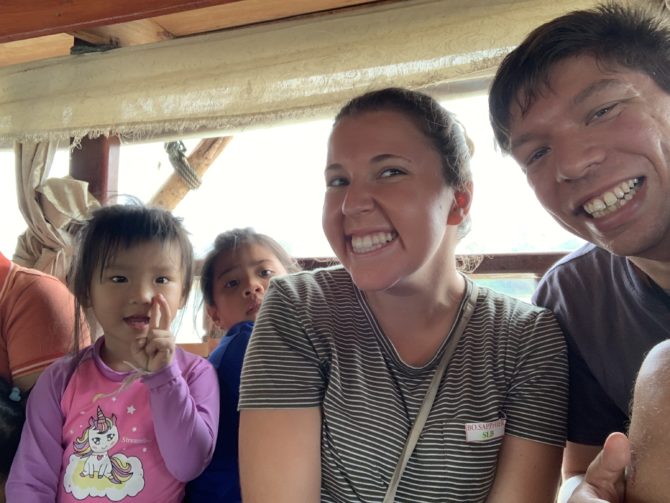
Pak Beng may be small but we found a wonderful restaurant for dinner after eschewing the bar and wandering along its main (and only?) road, lit by two small bonfires and minimal electricity. The bread for sale, on the other hand, is truly the worst bread. It tasted like it came from a children’s plastic play set. All of the other food we’ve had in Laos has been exceptionally good – and the fish which Randi ordered last night might be the best fish I’ve ever tasted – so if you’re visiting, please just eat anything other than a baguette.
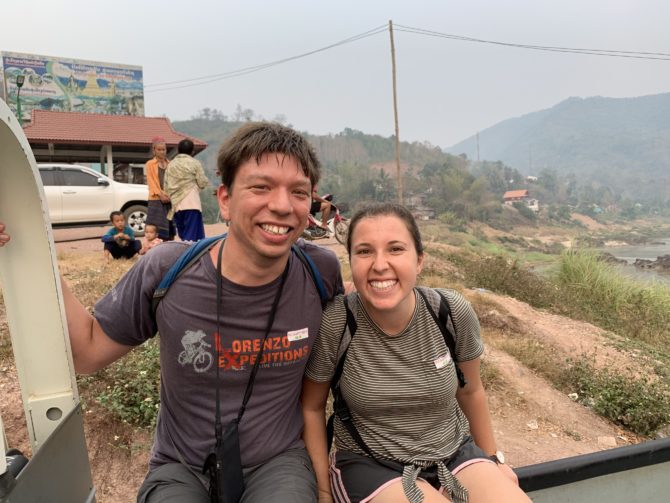
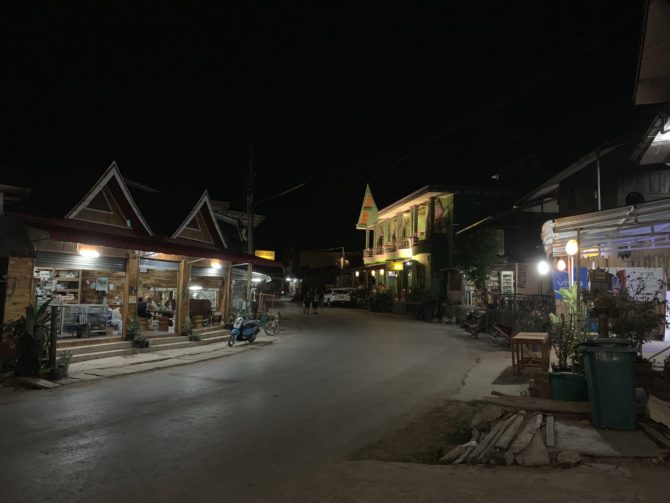
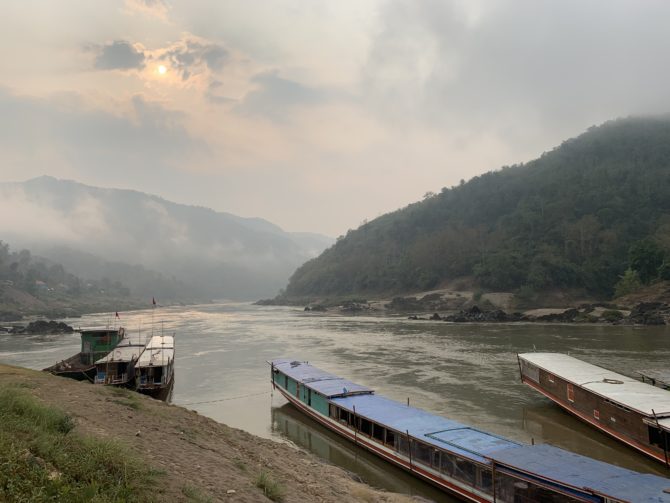
We arrived into Luang Prabang the following afternoon after a less crowded boat ride. Remarkably, I could even read my Kindle on it without getting a headache, which is very rare for me and boats. Luang Prabang is surprisingly small. You’re spared a paragraph in this post about the public transport around town because there’s no need: everything was easily walkable from our AirBnb by the river. In the centre is a small hill, Phou Si, which is common to walk up (there are stairs) to watch the sunset from the temple at the summit. It’s the one time in Laos where it did feel a little crowded, but the sun was full of colour in a way which is never quite captured on photos. (This is true even in those photos where people pose ‘holding’ the sun, which I have now seen done sixty thousand times during our travels.)
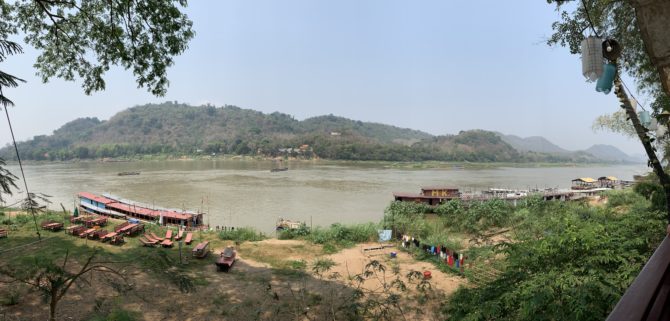
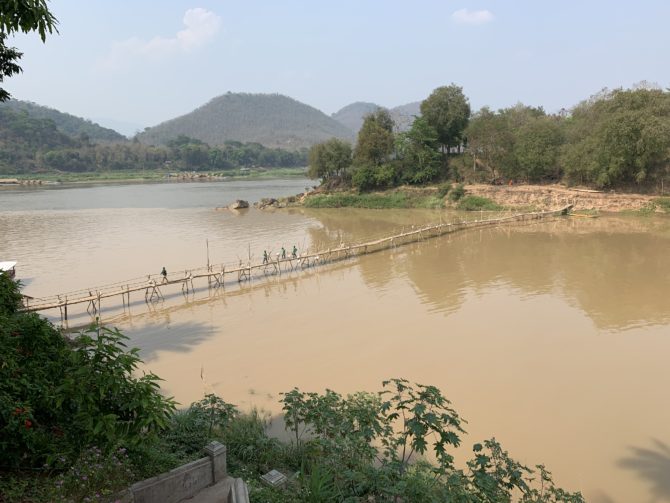
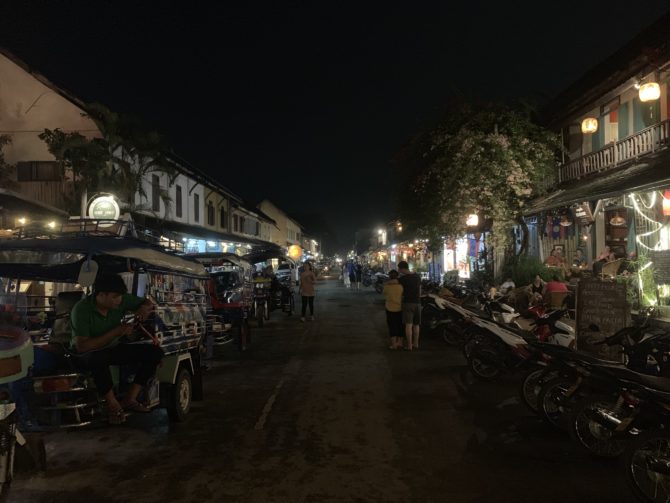
Yesterday we ventured out of town early to get to the Kuang Si Falls before the crowds. We began with the trek to the top of the waterfall where we discovered that the disadvantage of getting there early is that you get to be the ones to break a lot of spider’s webs. On the other hand, the whole place is beautiful and peaceful enough to sit and read by the main waterfall before getting changed and going for a quick dip around some of the lower falls. We did not go to investigate the “secret falls” described on some travel blogs, which always include a quick confession that they had to get past a locked gate and fencing to get there. I’m not sure everyone understands the difference between “secret” and “closed”.
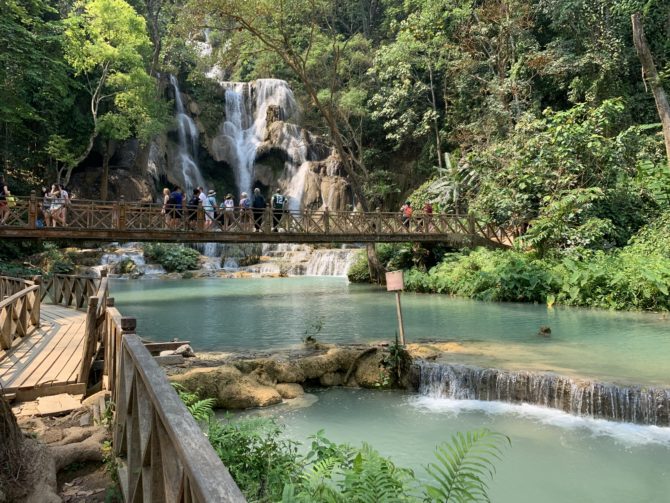
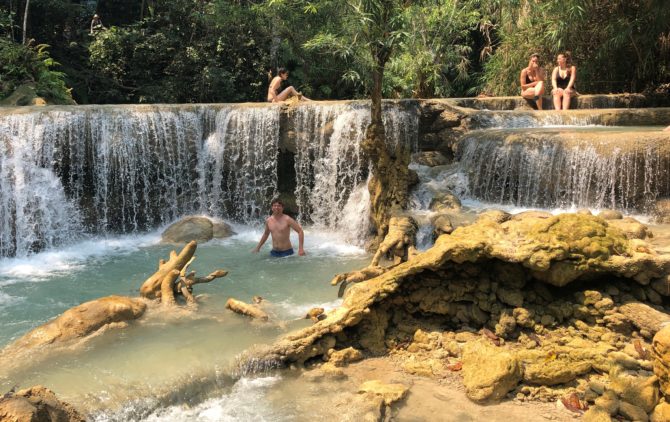
Tonight we’re leaving Laos and flying to Hanoi. I feel a little bad about this. I had wanted to get across Southeast Asia with no short-hop flights, but (as mentioned) there are no trains and we chickened out of our original plans to take the 24-hour bus. (This trip is mostly described online as the ‘Journey from Hell’ although one British blog summed it up as ‘Not So Bad’ which British people will recognise as meaning roughly the same thing.) But I can totally see why some people – including our AirBnb host – visit Laos and then end up staying for years. If you are in the region, don’t miss it out!
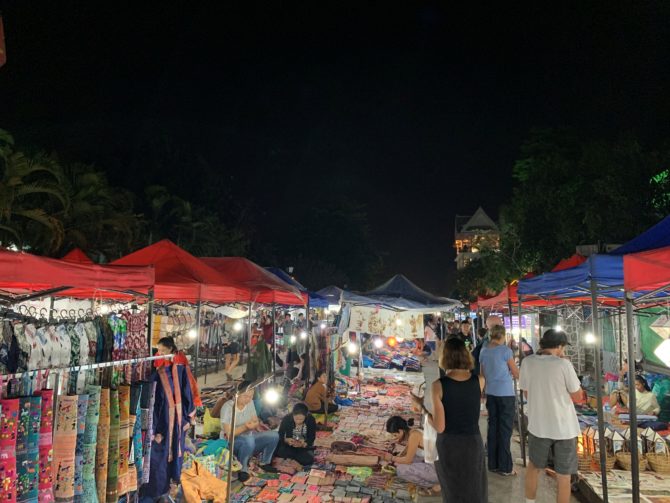
Fair warning: this post is going to be overloaded with elephant photos. If you really hate elephants, skip this one.
We only had two days to spare in Chiang Mai, so soon after arriving at our hostel we moved quickly to book the tours we wanted while we were here. This left us with a couple of hours to conduct an improvised whistle-stop tour of the old town by ourselves, which is quite walkable and surrounded by remnants of old city walls, but – like the rest of Chiang Mai – suffers from a perpetual haze of pollution at this time of year (caused by agricultural land burning) which greys out the sky. Thankfully neither of us started coughing up blood but we were happier to skimp on the city than we might otherwise have been. Well, that and there’s a limit to the number of temples which can hold your interest.
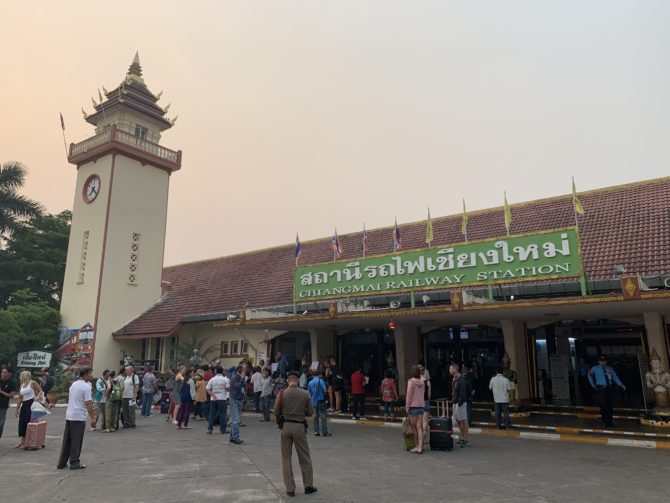
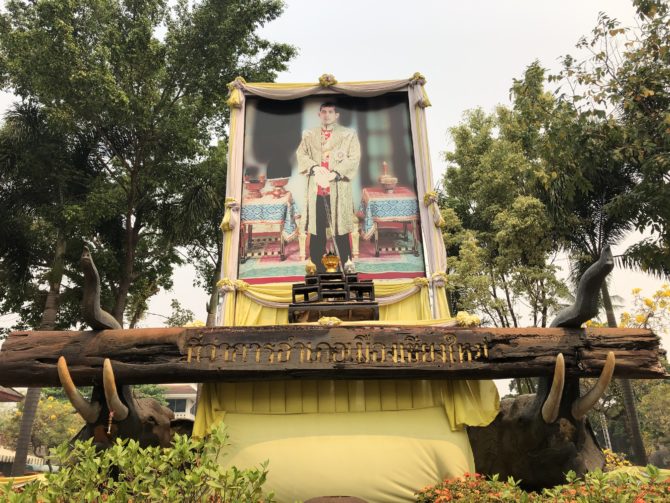
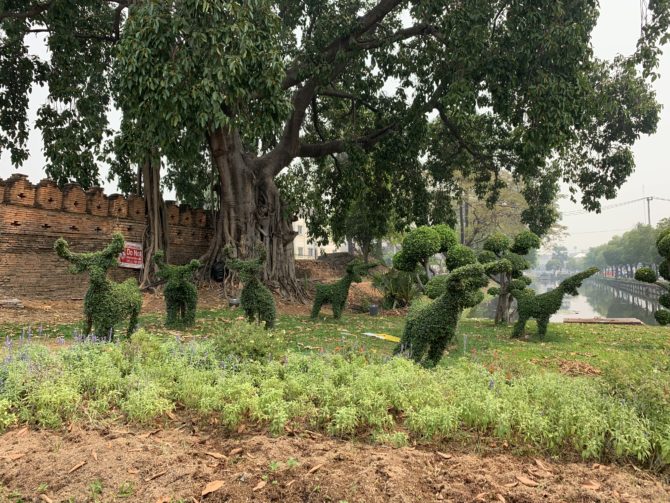
Less time for the city meant more time for elephants! We went on a half-day visit to Toto’s Elephant Sanctuary and when I compare it to the last time I saw elephants, in Sri Lanka, the difference is profound. Our tour group consisted of one minivan’s worth of people (side note: I was childishly proud of drawing little flags in the ‘Nationality’ column of the visitor form we had to fill in, because the next person from China felt compelled to continue the pattern) and the atmosphere at the sanctuary was incredibly relaxed and chilled. We did not ‘take the elephants for a walk’, we followed the elephants as they wandered into the jungle at their own pace. Unlike Sri Lanka there were no chains or hooks in use, just a handful of cheerful elephants including one bounding eight-month old who kept charging about and occasionally slipping over.
The photos speak for themselves, but it was wonderful to spend time with these improbable creatures. At one point Randi was concerned that we might be feeding them too many bananas and asked if it was possible to overfeed them, but was reassured that they consume 300kg a day and are basically always eating.
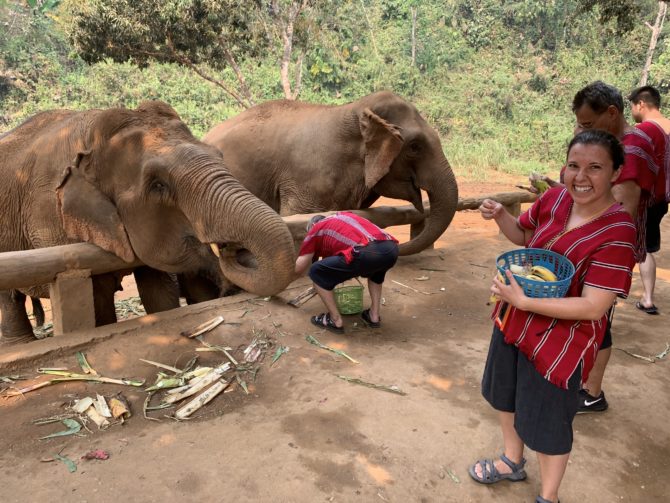
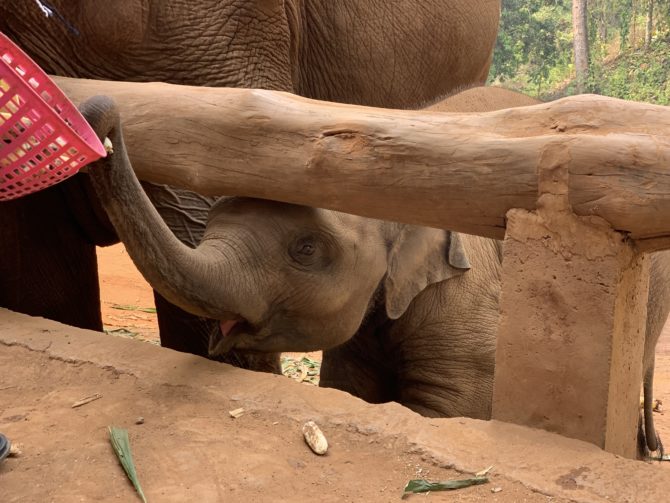
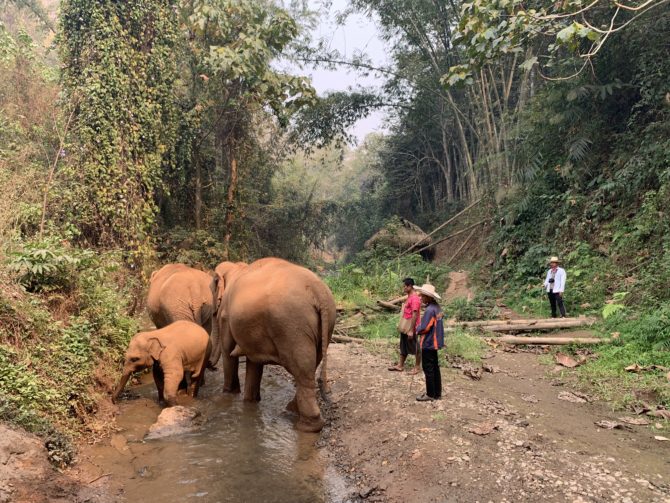
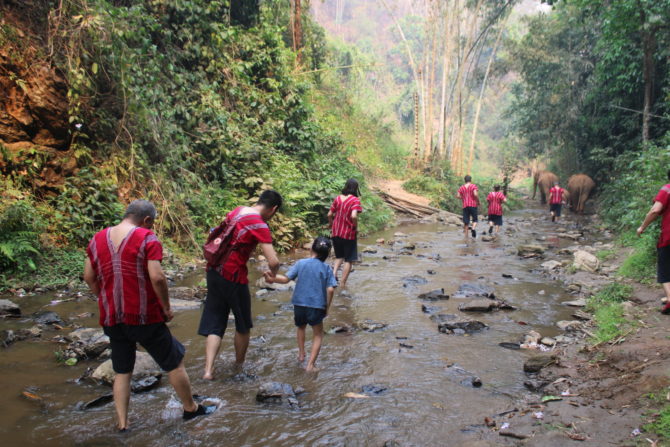
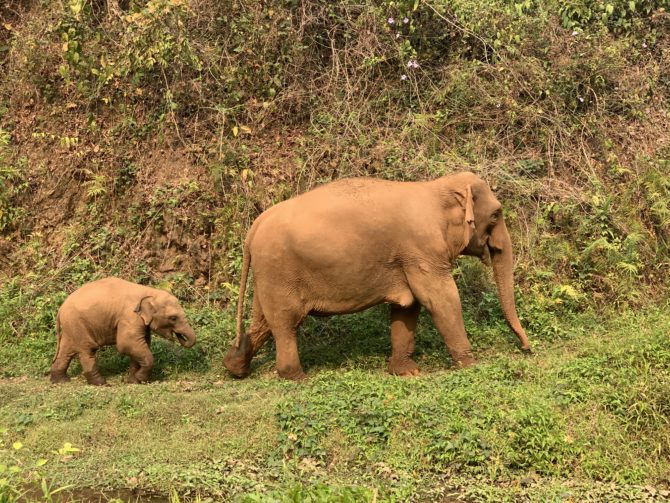
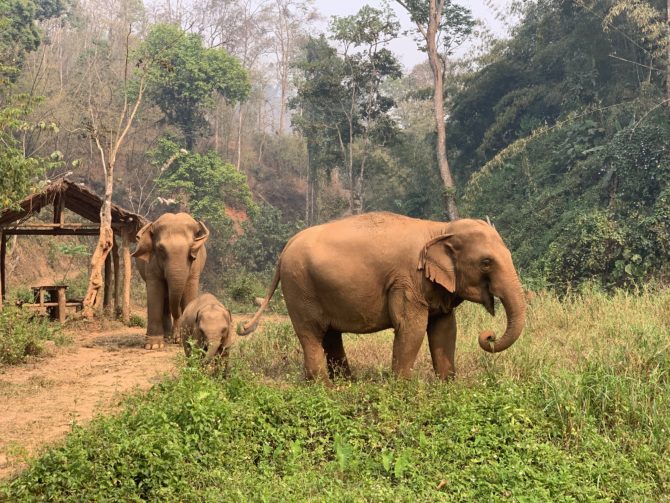
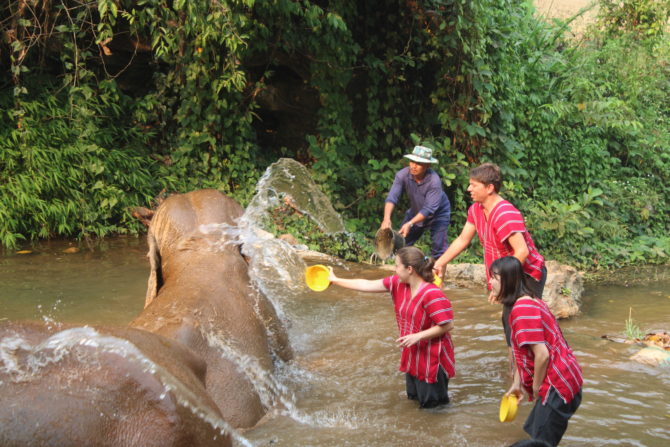
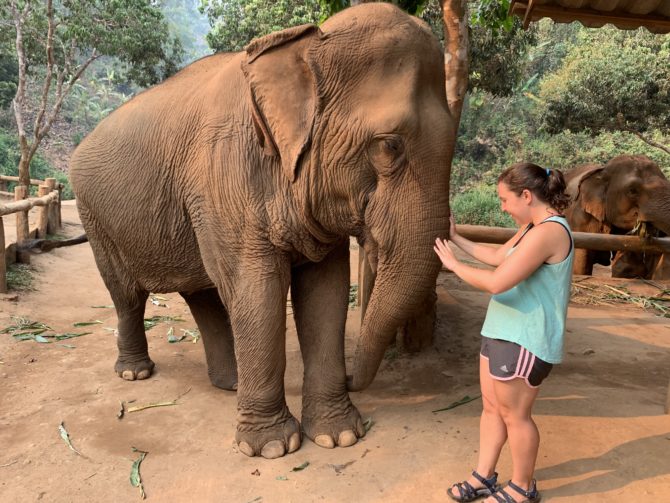
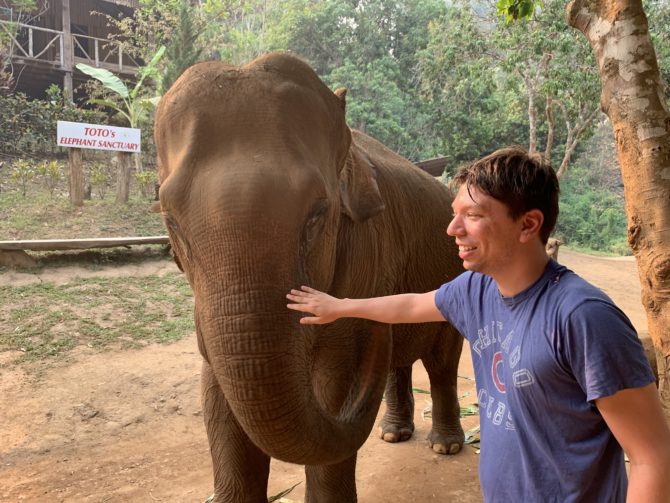
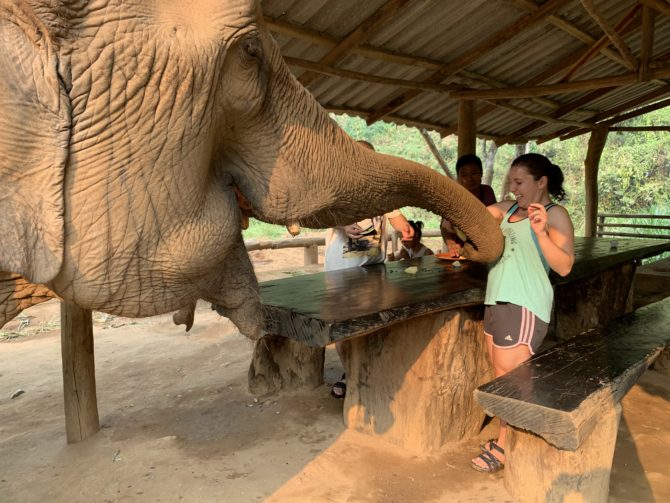
Our tour the next day was a jungle trek just outside the Doi Inthanon National Park. Aside from the very windy drive to the starting point this was a really, really lovely tour thanks to our amazing guide, who took the two of us from his village through the most jungley environment I’ve ever been in. The ‘path’ was tentative at best, covered in slippery leaves which our guide kept brushing out of our way, and he led us along armed with a large knife put to a great many uses including cutting back plants growing over the route, fashioning us impromptu walking sticks and slicing through the branch of one particular tree to show how we could drink the water inside.
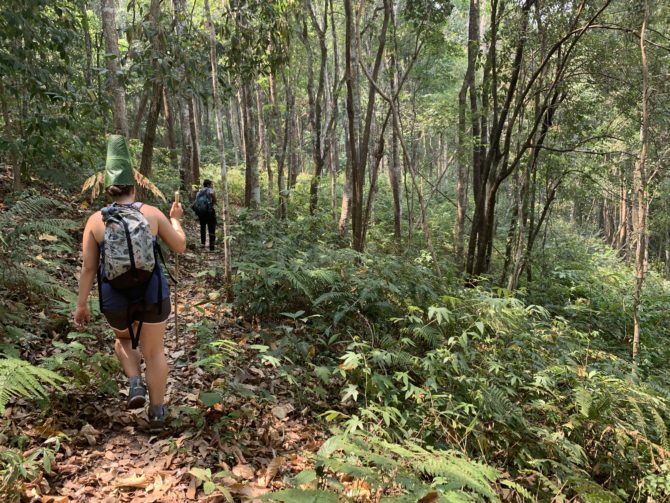
We also really enjoyed our conversations together. His English was halting (entirely self-taught over the last couple of years of doing tours) but we learnt of his desire to visit Europe one day if he ever saved up enough money to take his first plane. There was also a tragic moment where he asked Randi if Barack Obama was still President, and even though it’s now 2019 she had to break the news to one more person in the world about Trump. (He had never heard of him, which was rather refreshing.)
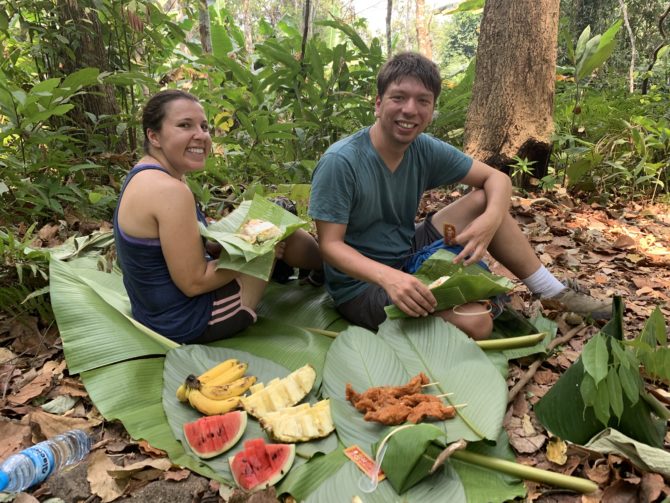
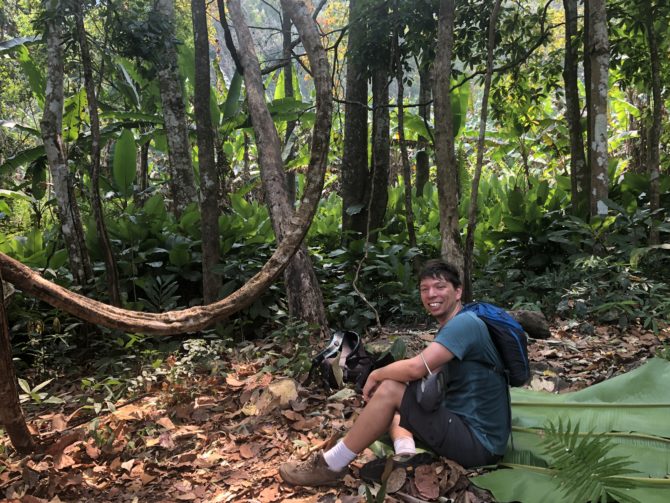
The tour ended at another elephant sanctuary and freezing cold waterfall which I begrudgingly took a quick shower in, and have to admit was somewhat refreshing. Back at the hostel, we took advantage of the free hour-long massages which the hostel offer in return for booking tours through them. Having worked at Groupon for many years I was well aware that there are both ‘nice soothing massages’ and ‘fearsome stretchy massages’ in the world but have never actually paid for one before and certainly didn’t remember which was which. Well, it turns out that the ‘Thai massage’ is the scary one… although I did enjoy the experience. I imagine it’s like being tortured by a professional torturer (wait, this isn’t going to be as bad as it sounds) only working to a much lower threshold of pain. Controlled and purposeful, in other words, and not just being beaten up by a masseuse.
Other than a brief visit to the extremely crowded Saturday night market along Wualai Walking Street (and our quick escape to an Indian restaurant) that pretty much sums it up for Chiang Mai. The next day we spent most of the day being driven to the Thai border town of Chiang Khong ready for our slow boat into Laos tomorrow, but we did stop briefly at the White Temple (Wat Rong Khun) in the province of Chiang Rai. We didn’t actually go in, but even from the outside this still ranks pretty high in the temple index, probably because it turns out to have been repurposed as an art exhibit.

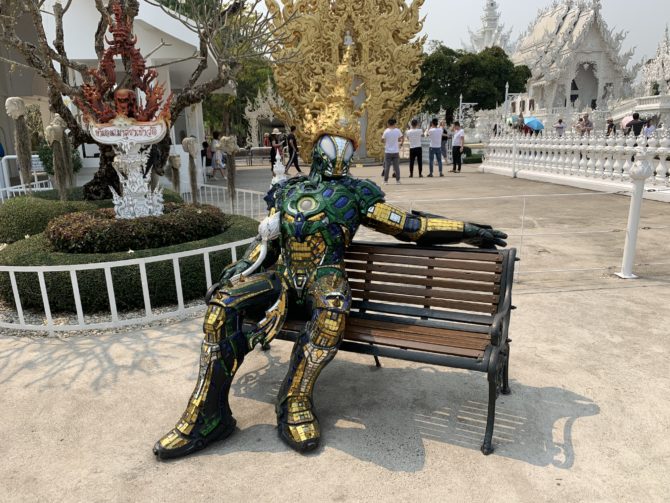
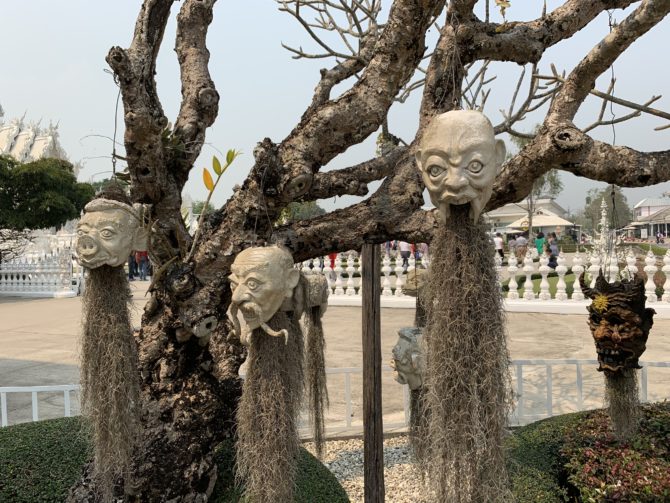
We’ve seen a real variety of places within Thailand, but after Koh Lipe I think this was the stop I most enjoyed thanks to the elephants and the jungle. I am really not sure what to expect of Laos, but armed with the US dollars required for the entry visa I am ready for the next stage of our journey.
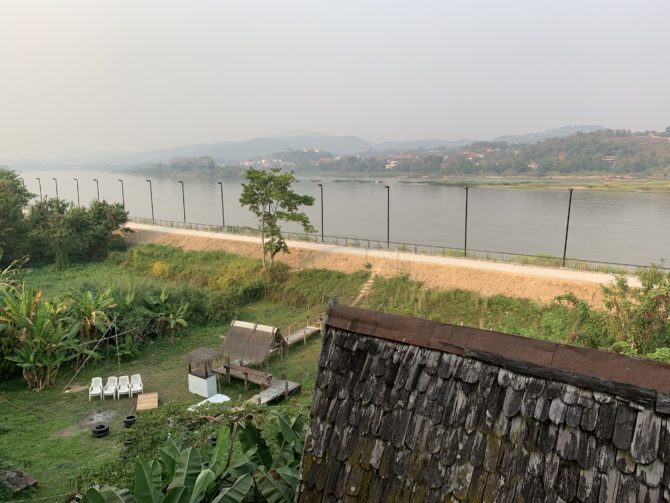
The feeling of having made it successfully onto your sleeper train as it pulls away from the station – especially as you relax into a private cabin and watch the platform start to disappear past your window – is a really special one, and I don’t understand anyone who wouldn’t feel the thrill in this. So began our overnight train to Bangkok, leaving a little late (but not drastically)
from Surat Thani and arriving about an hour behind schedule at 9.30 in the morning. The train itself was nothing fancy but similar to other sleeper trains I’ve ridden and we slept reasonably well, although I’m writing this from the future – after our incredible train out of Bangkok to Chiang Mai – which is warping my memory a little. More on that later.
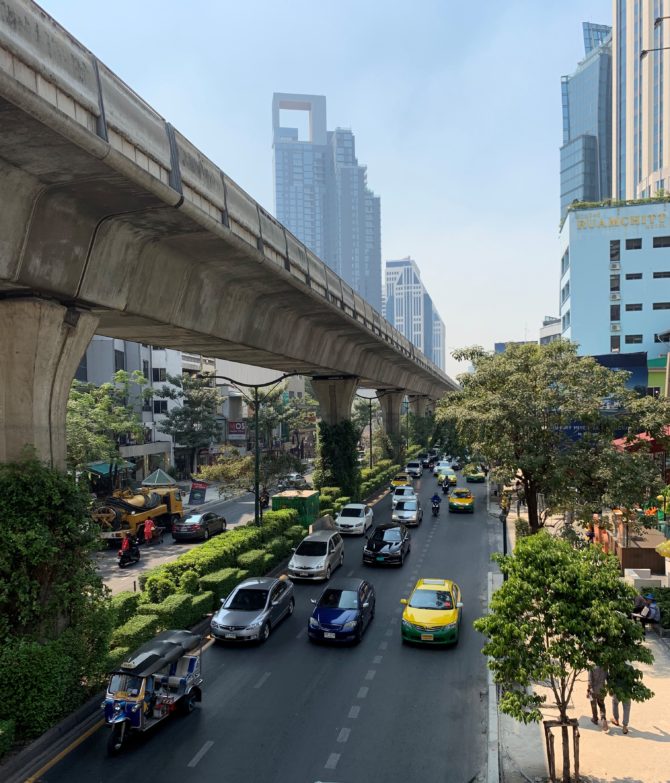
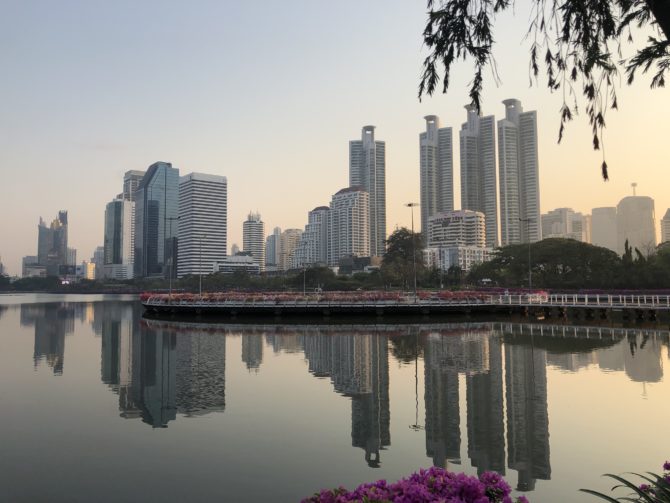
We were very generously lent an apartment to stay in by the parents of one of Randi’s school friends (thank you!) and to get there from the main train station involved an introduction to Bangkok’s two main rail systems: the MRT (a subway) and the BTS Skytrain (an elevated train). Bear in mind that neither of these existed in any form until 1999 – I can’t imagine how awful it would have been to get around without them – and both systems are growing at a brisk pace, to the extent that the majority of stations on the MRT map are “future stations” which do not actually exist yet. So overall, I was very impressed. But the most galling flaw is that they use two completely separate smartcard systems for payment, even though they have been built to interchange with each other!
The Thai government has been promising to introduce an integrated Mangmoom Card (or ‘spider card’) for years, but it still doesn’t work. In the meantime, it’s BTS which has made the running with a cute ‘Rabbit card’ which can also be used to pay for meals at one of the food courts we visited. So we opted for that one and stuck with plastic tokens on the subway, refusing to shell out deposits for two different cards. Please keep working on this, Bangkok.
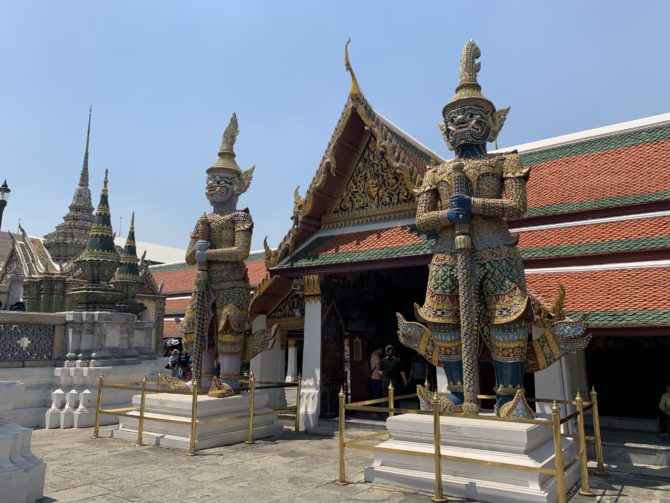
The most obvious thing to do when visiting the city is to visit the Grand Palace, the former site of the royal family and Thai government which is a large complex of courts, palaces and the Temple of the Emerald Buddha. We got there by taking a public boat up the river – no, the public boat doesn’t work with either of the smartcard systems I mentioned earlier, don’t be silly – and I was proud of us for walking determinedly past the staff misleading flogging the tourist boat at the pier (60 baht per person) and finding the right table for the ‘real’ boat instead (20 baht per person). You have to be jealous of your baht when visiting the Grand Palace since it is rather expensive in addition to being very hot and crowded, which definitely takes away the charm. That said, I did enjoy the quieter section at the back with the extensive murals depicting the national epic.
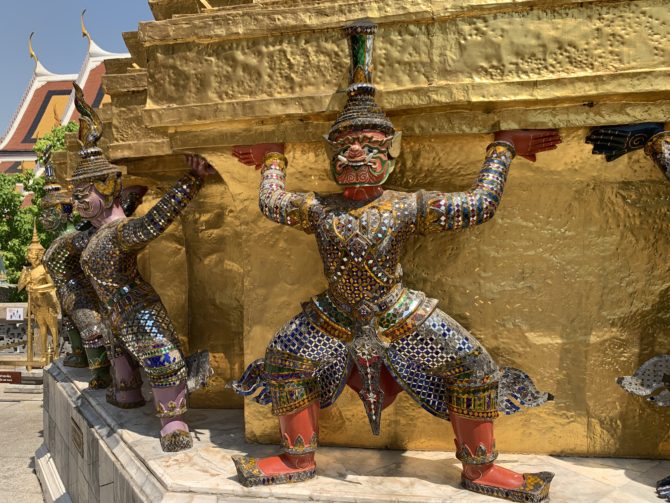
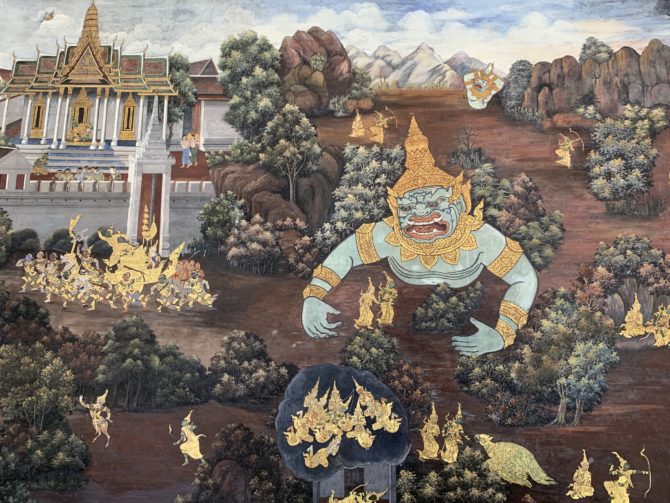
Thailand’s current government is a military junta after their coup in 2014, but new elections are now scheduled for the end of next week. I have not read up enough on the situation to understand what exactly is going on, but the roadsides of Bangkok are littered with posters for a plethora of different parties including – my favourite – whoever is campaigning with the somewhat complacent slogan #NoProblem. (Disclaimer: not an actual endorsement.) A couple of times we also saw vans driving past playing election material out of loudspeakers. We will be out of the country for the election itself but we are scheduled to return to Bangkok at the very end of our travels so we’ll have to keep an eye on what happens here.
Our other adventures in Bangkok included the Ratchada Train Market – an enormous night market with lots and lots of food – and Lumphini Park, where Randi joined in with the nightly aerobics class and I sat happily and read instead. We also had multiple cheap and cheerful lunches at the food court at Terminal 21, an airport-themed shopping centre (because who doesn’t love airports?) where each floor represents a different destination, from London to Paris to Tokyo to San Francisco to San Francisco again. (I don’t understand why… it’s not like they ran out of places in the world.)


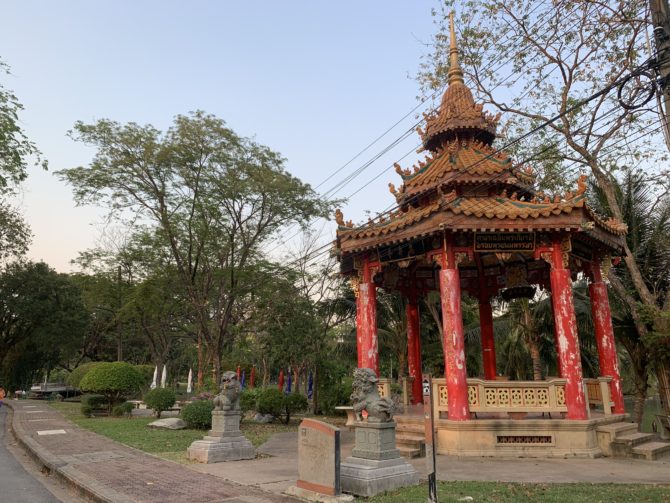
It’s difficult to sum up Bangkok and we obviously only saw a small sliver of it, but I look forward to coming back and hope to uncover a little more then. What I absolutely adored, however, was how we left: the #9 Express Train overnight to Chiang Mai. This was possibly the nicest train I’ve ever taken even though this time we were only travelling second class. Instead of cabins, second class bunks (sofas during the day) are lined up ‘airline style’ along the sides of the train, each with their own electrical sockets and curtains for privacy.
It may not sound quite as nice as a private room but I think I actually preferred it, feeling very snug in my top bunk hideaway. We also very much enjoyed the company of our opposite duo: two German girls from Passau who were shocked and appalled to learn that both Brits and Americans buy their multi-pack beer in cardboard containers rather than plastic beer crates. (Seriously, this really rattled them… they were just like me with American kettles.)
The only downside of this train is that they keep the bright lights turned on along the corridor all night, leading me to root around in my backpack for a blindfold. Luckily I had one (nicked from an airline by Randi) and was able to get some good sleep. It was, in fact, a little disappointing when the train arrived into Chiang Mai exactly on time at 7:15am because I would have enjoyed an even longer rest on that train. Definitely our most enjoyable journey to date.
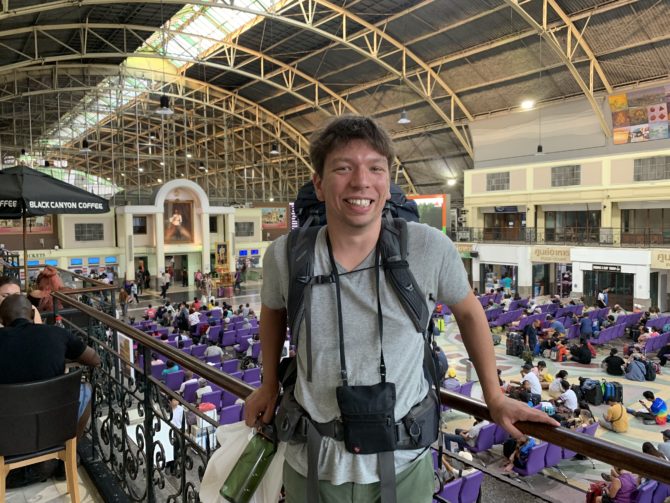
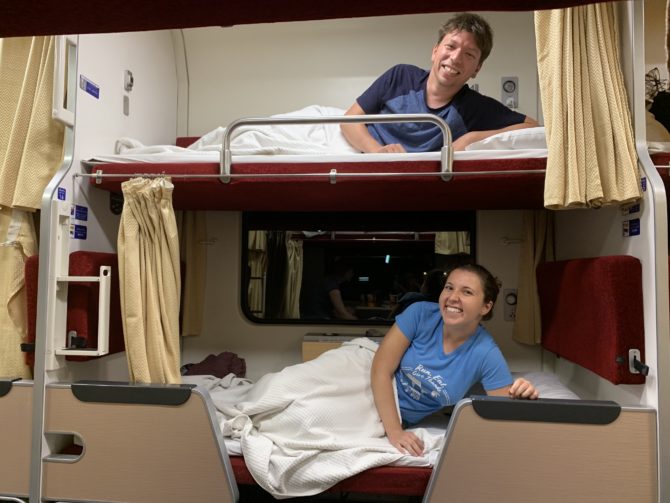
Phuket is another instance of an island – Thailand’s largest – unimaginatively sharing its name with the surrounding province. Usually visitors here stay at one of the many beach resorts, but we didn’t think anything could compare favourably to Koh Lipe so opted for a nicer AirBnb further inland, halfway between the busy Patong Beach and Old Phuket Town. A disadvantage of this scheme is that transport around the island is terrible, so we were a bit restricted in our roaming. On the other hand, there was a large Tesco up the road… though sadly without the meal deals.
Fortunately, location wasn’t an issue for the most important thing we came here for: a full-day tour of Phang Nga Bay in the Ao Phang Nga National Park. After being collected and then dropped off at Ao Por Pier (home to the world’s most persistent and effective salesperson for waterproof mobile phone pouches… we bought two) we were given the world’s silliest ticket for the journey “from the start to the end of the pier” before finally making it onto the boat which would take us around Phang Nga Bay.
From the boat we had two opportunities to jump into kayaks and explore the sea caves themselves, only with someone else doing all the hard work of paddling. They were beautiful:

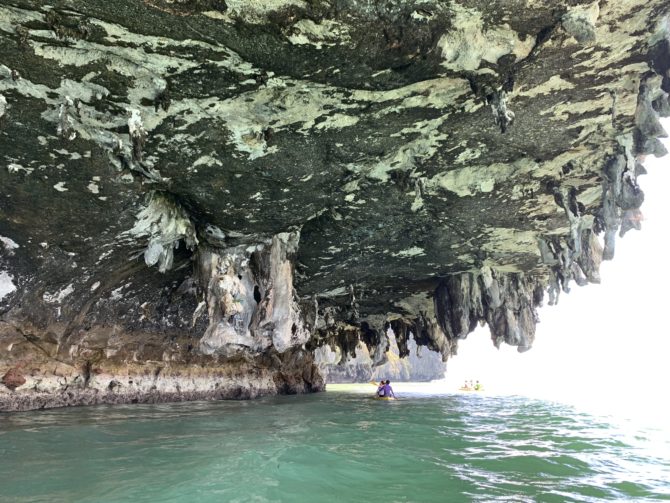
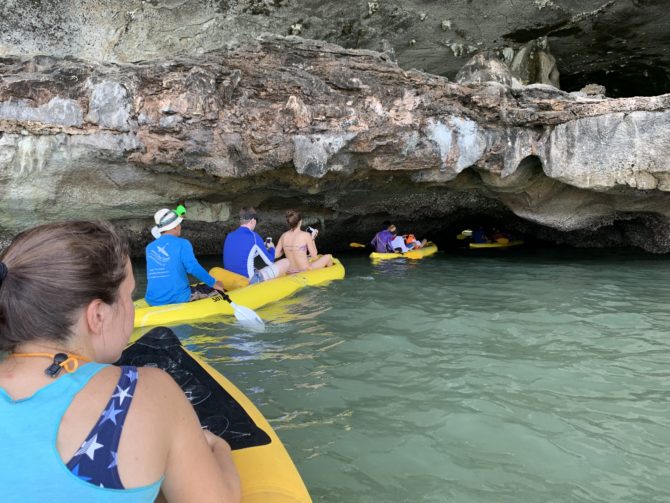
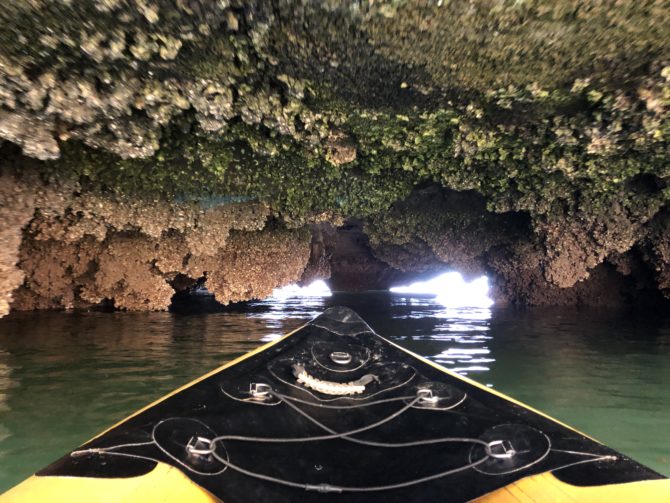
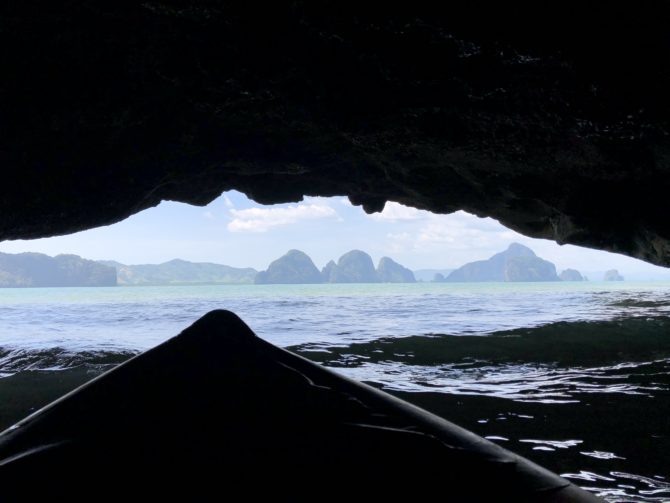
Aside from the expeditions to the caves we were very well taken care of on the boat itself, with snacks and drinks (I’m very grateful for that cup of tea) in addition to lunch and dinner. I’m normally a bit sceptical of boat meals but the buffet spread for dinner was amazing, especially the Massaman curry. During ‘free time’ we could either take the kayaks out ourselves or swim in the surrounding waters, assured that there were “not too many” jellyfish and that the staff would be keeping an eye out for them just in case. Obviously the water was just too tempting to say no.
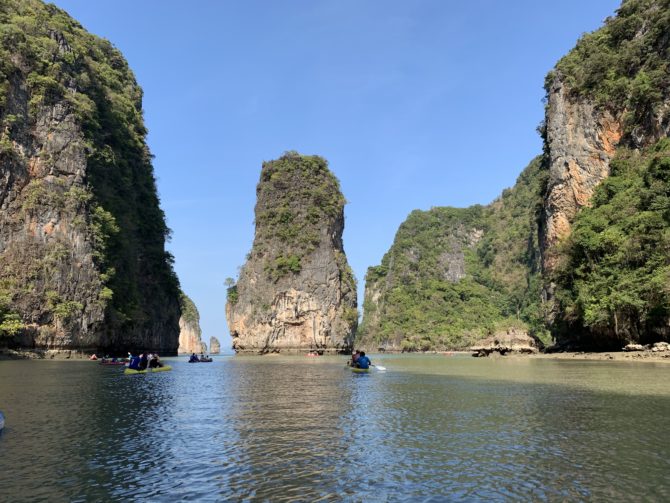
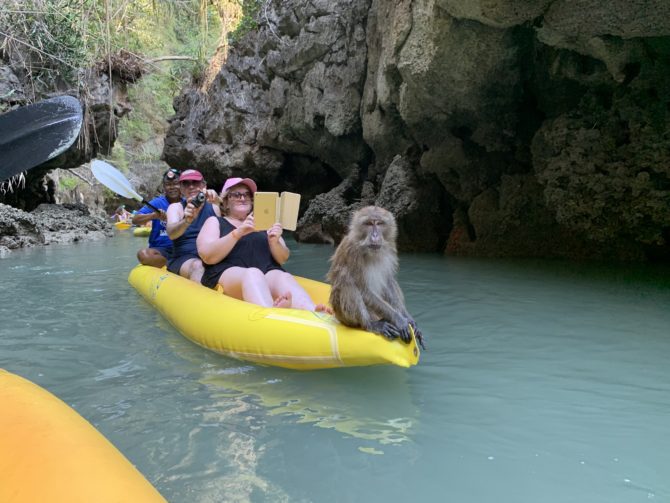
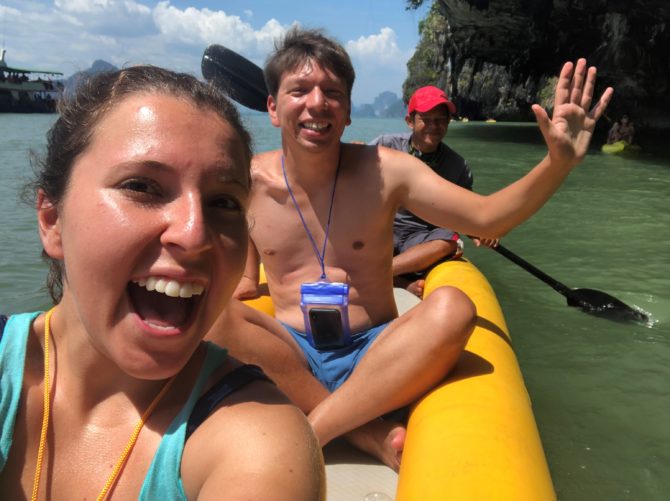
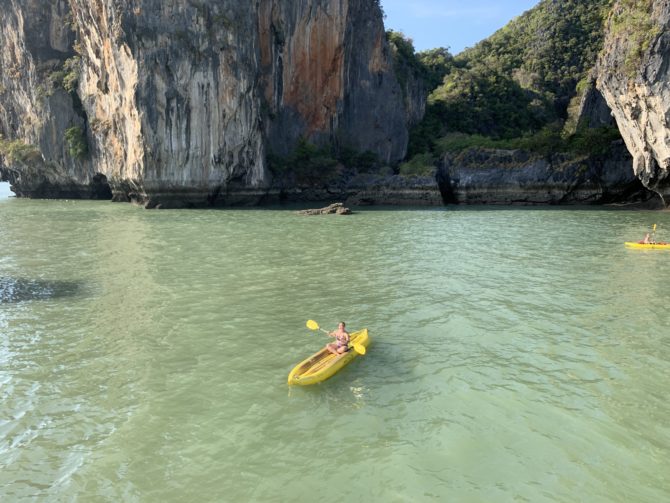
The final activity of the day was to make krathongs – decorated flower basket thingies which float down rivers during the Thai Buddhist festival of Loi Krathong. Side-note: this review was incredibly helpful to us when choosing a tour, but I am kinda amused by the tension between being sad that the krathongs are collected up again afterwards – going against local traditions – versus the environmental cost of dumping all of these tourist products into the sea every day. And unlike the author of that blog, arts and crafts is really not either of our jams so we were delighted when our appointed helper (the same guy who paddled our kayak) confessed that as a Muslim this whole tradition was a bit alien to him and he had had to learn it on the job.
All in all, I don’t think our team’s krathong is winning any awards, but once the candles were lit it did look rather nice floating on the water. Before we collected it back, of course.
For the rest of our time in Phuket we didn’t do anything incredibly amazing – unless you count laundry – but we did take the opportunity to plan out the rest of our travels across South East Asia and take some tentative steps towards our new lives in London. First steps like switching our Kindle accounts over to the UK 😉 and discovering – quite shockingly – that Kindle books are generally a fair bit cheaper in the UK versus the US, even though they include 20% VAT. It’s very curious.
We did go out to three destinations: Old Phuket Town, Patong Beach and the Big Buddha statue. Where possible we used the local bus – which usually takes the form of a converted pick-up truck – because the prices of taxis (including Grabs) are absurdly inflated and very obviously subject to a taxi mafia which really did hold back our casual tourist spending. It’s a bit of a miracle that the bus service exists at all, and is sorta charming once you get onto it, but service is skimpy and stops completely around 5-6pm in the evening. I’ve also never been less confident that we’d make it up a hill. Excitingly, there is a light rail scheme coming to the island but not until 2023-24 (in theory) so getting around will be frustrating for a while yet.
Incidentally, many of the guides and reviews advise you to hire a motorbike to get around the island more easily. You certainly could do that… or you could read the WHO’s 2015 Road Safety Institutional and Legal Assessment for Thailand, a country with the second-highest road fatality rate in the world of which over 70% were motorcycle drivers.
However you choose to visit Old Phuket Town, you won’t find somewhere very buzzing – at least during the middle of the hot day – although of course there is delicious and cheap Thai food available. Patong Beach, meanwhile, was a perfectly nice beach to wander up and down, but the vibe is much more “party town” than “relaxing beach paradise” and this only accelerates after the sun goes down and the ping pong sex shows begin. (Feel free to Google this if you feel the need, but I think my audience prefers WHO reports.) We spent a token amount of time on the main drag before Randi checked off the life goal of eating Burger King’s veggie burger and we got our extortionate taxi out of there.
Finally, the Big Buddha is moderately interesting to walk around and comes with a great view overlooking the island. Again, we would have enjoyed it more if the transport costs were not so high… although this was the one occasion where we bothered to haggle a taxi price down from “absurd” to only “quite ridiculous”.
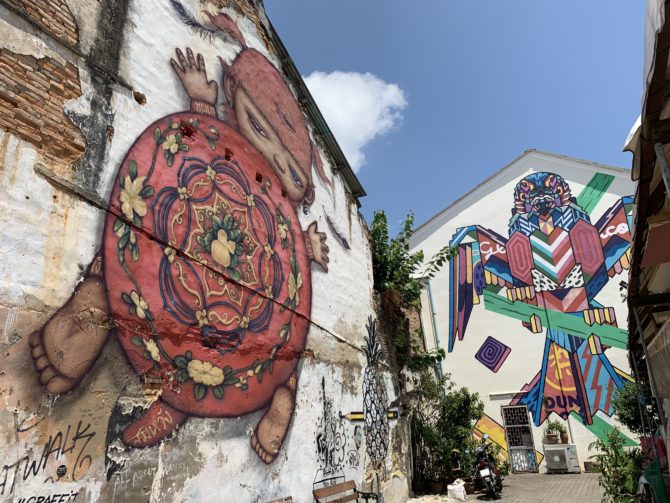
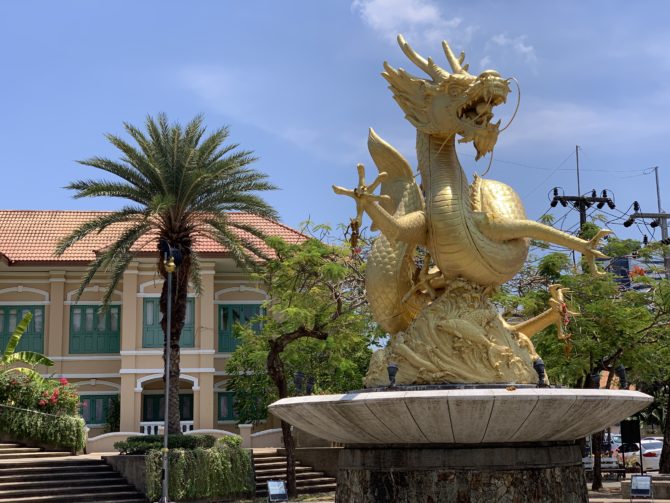
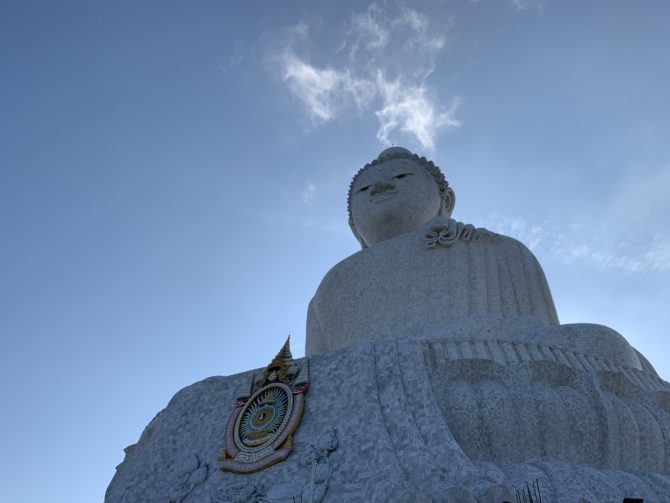
One last random snippet which I think is worth sharing: at Ao Por Pier, a selfie stick is not a selfie stick but instead a “Self Picture Monopod for Mobile Phones”. Well, I liked it.
As you can probably tell, we did not really fall in love with Phuket other than as a base for Phang Nga Bay which justified the whole stop. We are now finishing off our blogs in a café opposite the railway station in Surat Thani, which is a four hour drive from Phuket and the closest station available for an overnight train to Bangkok. I am not expecting the world’s most comfortable sleep, but I am excited for the first sleeper train of our travels!
